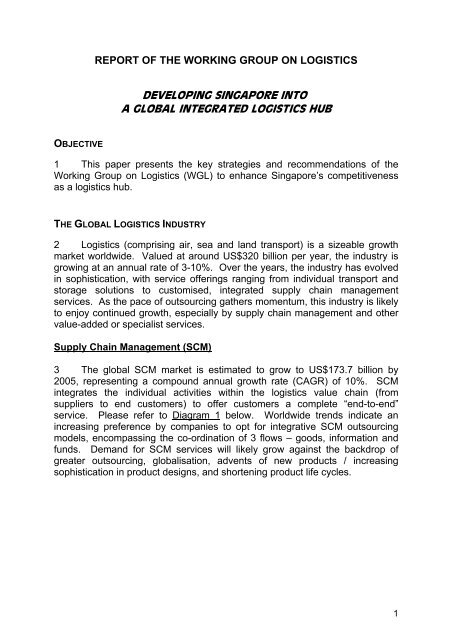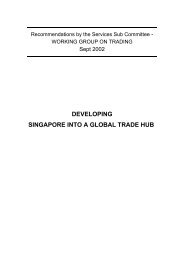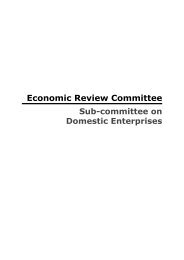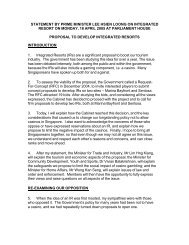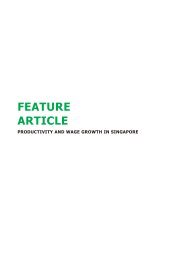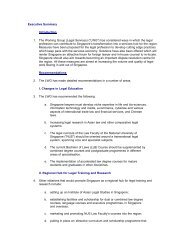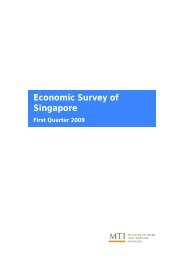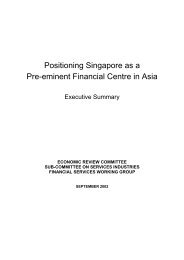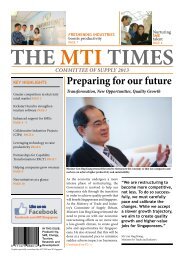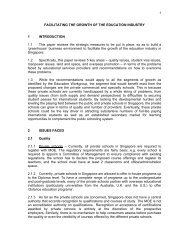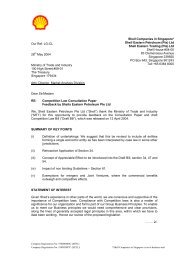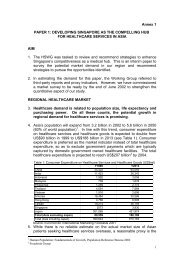Report of the working group on logistics - Ministry of Trade and ...
Report of the working group on logistics - Ministry of Trade and ...
Report of the working group on logistics - Ministry of Trade and ...
- No tags were found...
You also want an ePaper? Increase the reach of your titles
YUMPU automatically turns print PDFs into web optimized ePapers that Google loves.
REPORT OF THE WORKING GROUP ON LOGISTICSDEVELOPING SINGAPORE INTOA GLOBAL INTEGRATED LOGISTICS HUBOBJECTIVE1 This paper presents <str<strong>on</strong>g>the</str<strong>on</strong>g> key strategies <strong>and</strong> recommendati<strong>on</strong>s <str<strong>on</strong>g>of</str<strong>on</strong>g> <str<strong>on</strong>g>the</str<strong>on</strong>g>Working Group <strong>on</strong> Logistics (WGL) to enhance Singapore’s competitivenessas a <strong>logistics</strong> hub.THE GLOBAL LOGISTICS INDUSTRY2 Logistics (comprising air, sea <strong>and</strong> l<strong>and</strong> transport) is a sizeable growthmarket worldwide. Valued at around US$320 billi<strong>on</strong> per year, <str<strong>on</strong>g>the</str<strong>on</strong>g> industry isgrowing at an annual rate <str<strong>on</strong>g>of</str<strong>on</strong>g> 3-10%. Over <str<strong>on</strong>g>the</str<strong>on</strong>g> years, <str<strong>on</strong>g>the</str<strong>on</strong>g> industry has evolvedin sophisticati<strong>on</strong>, with service <str<strong>on</strong>g>of</str<strong>on</strong>g>ferings ranging from individual transport <strong>and</strong>storage soluti<strong>on</strong>s to customised, integrated supply chain managementservices. As <str<strong>on</strong>g>the</str<strong>on</strong>g> pace <str<strong>on</strong>g>of</str<strong>on</strong>g> outsourcing ga<str<strong>on</strong>g>the</str<strong>on</strong>g>rs momentum, this industry is likelyto enjoy c<strong>on</strong>tinued growth, especially by supply chain management <strong>and</strong> o<str<strong>on</strong>g>the</str<strong>on</strong>g>rvalue-added or specialist services.Supply Chain Management (SCM)3 The global SCM market is estimated to grow to US$173.7 billi<strong>on</strong> by2005, representing a compound annual growth rate (CAGR) <str<strong>on</strong>g>of</str<strong>on</strong>g> 10%. SCMintegrates <str<strong>on</strong>g>the</str<strong>on</strong>g> individual activities within <str<strong>on</strong>g>the</str<strong>on</strong>g> <strong>logistics</strong> value chain (fromsuppliers to end customers) to <str<strong>on</strong>g>of</str<strong>on</strong>g>fer customers a complete “end-to-end”service. Please refer to Diagram 1 below. Worldwide trends indicate anincreasing preference by companies to opt for integrative SCM outsourcingmodels, encompassing <str<strong>on</strong>g>the</str<strong>on</strong>g> co-ordinati<strong>on</strong> <str<strong>on</strong>g>of</str<strong>on</strong>g> 3 flows – goods, informati<strong>on</strong> <strong>and</strong>funds. Dem<strong>and</strong> for SCM services will likely grow against <str<strong>on</strong>g>the</str<strong>on</strong>g> backdrop <str<strong>on</strong>g>of</str<strong>on</strong>g>greater outsourcing, globalisati<strong>on</strong>, advents <str<strong>on</strong>g>of</str<strong>on</strong>g> new products / increasingsophisticati<strong>on</strong> in product designs, <strong>and</strong> shortening product life cycles.1
Diagram 1: Activities Making Up <str<strong>on</strong>g>the</str<strong>on</strong>g> Supply ChainWith Sea And Air Transport At Its Core, The Logistics SectorComprises A Complex Set Of ActivitiesSupplierAssembly<strong>and</strong> testingWarehousing/Distributi<strong>on</strong>Warehousing/Distributi<strong>on</strong>L<strong>and</strong>transportPort /TerminalMaritime<strong>and</strong> airtransportPort /TerminalL<strong>and</strong>transportAssembly<strong>and</strong> testingCustomerTransport-relatedsupport activitiesHeavyengineeringShip bldg &repairBunker &supplysvcsL<strong>and</strong>transportsvcsReverse <strong>logistics</strong>Avi<strong>on</strong>icsValue added servicesAviati<strong>on</strong>svcsThird / Fourth Party Logistics, IT, R&DLegal, Tax, C<strong>on</strong>sultancyFinancing, InsuranceEducati<strong>on</strong> <strong>and</strong> TrainingSource:JP Morgan Research, TDB, WGL, BCG analysis- 2 -SCM –Asia Pacific4 The Asian SCM market is poised for robust growth. Annual SCM growthrates are projected at 7% in Europe, 10% in North America, <strong>and</strong> 15% in Asia.The high growth rates for Asia are c<strong>on</strong>firmed by a JP Morgan Research surveywhich showed that Asian shippers have outsourced <strong>on</strong>ly about 2.5% <str<strong>on</strong>g>of</str<strong>on</strong>g> <str<strong>on</strong>g>the</str<strong>on</strong>g>ir<strong>logistics</strong> functi<strong>on</strong>s as compared to between 20%-25% by <str<strong>on</strong>g>the</str<strong>on</strong>g>ir US <strong>and</strong>European counterparts. There is thus propensity for growth. The survey alsorevealed that Asian companies are showing str<strong>on</strong>g interest in revamping <str<strong>on</strong>g>the</str<strong>on</strong>g>irsupply chains <strong>and</strong> integrating <str<strong>on</strong>g>the</str<strong>on</strong>g>m with operati<strong>on</strong>s worldwide.5 Within Asia, China is touted to be a major growth locomotive. TheChinese government has recognised that transport <strong>and</strong> <strong>logistics</strong> is animportant pillar <str<strong>on</strong>g>of</str<strong>on</strong>g> <str<strong>on</strong>g>the</str<strong>on</strong>g> country’s ec<strong>on</strong>omic growth, <strong>and</strong> is taking steps toaccelerate <str<strong>on</strong>g>the</str<strong>on</strong>g> liberalisati<strong>on</strong> <str<strong>on</strong>g>of</str<strong>on</strong>g> <str<strong>on</strong>g>the</str<strong>on</strong>g> transport <strong>and</strong> <strong>logistics</strong> sector to support itsgrowing manufacturing activities <strong>and</strong> external trade. China’s <strong>logistics</strong> industryis estimated to be worth about US$12 billi<strong>on</strong>.SWOT ANALYSIS – SINGAPORE’S COMPETITIVE ADVANTAGES ANDCHALLENGES AHEAD6 Singapore’s key strengths are its world class infrastructure <strong>and</strong>c<strong>on</strong>nectivity. These make us <strong>on</strong>e <str<strong>on</strong>g>of</str<strong>on</strong>g> <str<strong>on</strong>g>the</str<strong>on</strong>g> world’s leading hub ports. However,<str<strong>on</strong>g>the</str<strong>on</strong>g>re are c<strong>on</strong>straints, key <str<strong>on</strong>g>of</str<strong>on</strong>g> which are:(a) Small domestic market <strong>and</strong> relatively high costs <str<strong>on</strong>g>of</str<strong>on</strong>g> operati<strong>on</strong>.2
(b) A highly fragmented industry with limited scale. The majority <str<strong>on</strong>g>of</str<strong>on</strong>g>businesses are small to medium-sized companies 1 . Without losingsight <str<strong>on</strong>g>of</str<strong>on</strong>g> <str<strong>on</strong>g>the</str<strong>on</strong>g> niche operators, this suggests <str<strong>on</strong>g>the</str<strong>on</strong>g> need to c<strong>on</strong>tinueattracting leading transport / <strong>logistics</strong> players to base <str<strong>on</strong>g>the</str<strong>on</strong>g>iroperati<strong>on</strong>s in Singapore <strong>and</strong> encourage greater collaborati<strong>on</strong> /alliances within <str<strong>on</strong>g>the</str<strong>on</strong>g> industry.(c) Increasing regi<strong>on</strong>al competiti<strong>on</strong>. This takes 2 forms:• Alternatives to Singapore <strong>and</strong> <str<strong>on</strong>g>the</str<strong>on</strong>g> regi<strong>on</strong> as locati<strong>on</strong>s forforeign direct investments (FDIs). For example <str<strong>on</strong>g>the</str<strong>on</strong>g> structuralshift <str<strong>on</strong>g>of</str<strong>on</strong>g> manufacturing activities to China <strong>and</strong> surroundingregi<strong>on</strong> may affect <str<strong>on</strong>g>the</str<strong>on</strong>g> potential volume <str<strong>on</strong>g>of</str<strong>on</strong>g> cargo flowingthrough Singapore.• Str<strong>on</strong>g rising aspirati<strong>on</strong>s <str<strong>on</strong>g>of</str<strong>on</strong>g> regi<strong>on</strong>al countries such as H<strong>on</strong>gK<strong>on</strong>g, Taiwan <strong>and</strong> Malaysia which are also positi<strong>on</strong>ing<str<strong>on</strong>g>the</str<strong>on</strong>g>mselves to become <str<strong>on</strong>g>the</str<strong>on</strong>g> preferred regi<strong>on</strong>al <strong>logistics</strong> hubs.7 Table 1 provides a summary <str<strong>on</strong>g>of</str<strong>on</strong>g> <str<strong>on</strong>g>the</str<strong>on</strong>g> SWOT analysis <str<strong>on</strong>g>of</str<strong>on</strong>g> Singapore’stransport <strong>and</strong> <strong>logistics</strong> industry.Table 1: SWOT Analysis <str<strong>on</strong>g>of</str<strong>on</strong>g> Singapore’s Transport & Logistics IndustrySTRENGTHS• Str<strong>on</strong>g physical infrastructure.• Good c<strong>on</strong>nectivity to major trading hubs<strong>and</strong> manufacturing bases (by both air <strong>and</strong>sea).• Major shippers <strong>and</strong> <strong>logistics</strong> serviceproviders have <str<strong>on</strong>g>the</str<strong>on</strong>g>ir regi<strong>on</strong>alheadquarters <strong>and</strong> <str<strong>on</strong>g>of</str<strong>on</strong>g>fices in Singapore.• Stable political, ec<strong>on</strong>omic <strong>and</strong> socialc<strong>on</strong>diti<strong>on</strong>s• An educated workforce.• A str<strong>on</strong>g legal system <strong>and</strong> businessfriendlytax structure.• Government is pro-active in openingdoors for businesses through bilateral<strong>and</strong> multilateral initiatives e.g. FTAs.WEAKNESSES• Relatively high costs <str<strong>on</strong>g>of</str<strong>on</strong>g> operati<strong>on</strong>(especially l<strong>and</strong> rental <strong>and</strong> wages)• Small geographic space <strong>and</strong> domesticmarket.• Industry is fragmented <strong>and</strong> lacks scale,with very few global players with globalaspirati<strong>on</strong>s.• Instances <str<strong>on</strong>g>of</str<strong>on</strong>g> lack <str<strong>on</strong>g>of</str<strong>on</strong>g> a <strong>logistics</strong> cluster /ecosystem.• Lack <str<strong>on</strong>g>of</str<strong>on</strong>g> resp<strong>on</strong>siveness to customers’needs.• Shortage <str<strong>on</strong>g>of</str<strong>on</strong>g> skilled, experienced <strong>and</strong>entrepreneurial <strong>logistics</strong> pr<str<strong>on</strong>g>of</str<strong>on</strong>g>essi<strong>on</strong>als.• Inadequate technological capabilities tocarry out a wide range <str<strong>on</strong>g>of</str<strong>on</strong>g> SCM1 65% <str<strong>on</strong>g>of</str<strong>on</strong>g> companies had turnover <str<strong>on</strong>g>of</str<strong>on</strong>g> less than S$1m. Those with turnover <str<strong>on</strong>g>of</str<strong>on</strong>g> more than S$5m makeup <strong>on</strong>ly 8% <str<strong>on</strong>g>of</str<strong>on</strong>g> <str<strong>on</strong>g>the</str<strong>on</strong>g> total number <str<strong>on</strong>g>of</str<strong>on</strong>g> establishments in <str<strong>on</strong>g>the</str<strong>on</strong>g> industry but c<strong>on</strong>tributed more than 75% <str<strong>on</strong>g>of</str<strong>on</strong>g> <str<strong>on</strong>g>the</str<strong>on</strong>g>industry’s value-added.3
activities.• Weak marketing <str<strong>on</strong>g>of</str<strong>on</strong>g> Singapore as a<strong>logistics</strong> / supply chain hub.• Lack <str<strong>on</strong>g>of</str<strong>on</strong>g> collaborati<strong>on</strong> between differentplayers <str<strong>on</strong>g>of</str<strong>on</strong>g> <str<strong>on</strong>g>the</str<strong>on</strong>g> supply chain.OPPORTUNITIES• Str<strong>on</strong>g growth potential for <strong>logistics</strong>outsourcing in Asia (US$80b 2 by 2012).• Specialised capabilities, dovetailing witho<str<strong>on</strong>g>the</str<strong>on</strong>g>r sector expansi<strong>on</strong> plans (e.g.biomedics <strong>and</strong> chemicals).• Leverage <strong>on</strong> Singapore’s goodc<strong>on</strong>nectivity to <str<strong>on</strong>g>the</str<strong>on</strong>g> Asia Pacific regi<strong>on</strong> toprovide total supply chain managementservices to shippers i.e. exp<strong>and</strong>hinterl<strong>and</strong>, especially to China (expectedto have annual growth rate <str<strong>on</strong>g>of</str<strong>on</strong>g> 7.4%).• Tap <strong>on</strong> <str<strong>on</strong>g>of</str<strong>on</strong>g>fshore trade c<strong>on</strong>ducted bySingapore-based trading companies,which is estimated at US$120b.THREATS• Relocati<strong>on</strong> <str<strong>on</strong>g>of</str<strong>on</strong>g> manufacturing <strong>and</strong>distributi<strong>on</strong> bases to o<str<strong>on</strong>g>the</str<strong>on</strong>g>r regi<strong>on</strong>alhubs (e.g. China).• O<str<strong>on</strong>g>the</str<strong>on</strong>g>r governments are aggressivelyimproving <str<strong>on</strong>g>the</str<strong>on</strong>g>ir <strong>logistics</strong> infrastructure<strong>and</strong> marketing <str<strong>on</strong>g>the</str<strong>on</strong>g>mselves as <strong>logistics</strong>hubs, giving rise to intense competiti<strong>on</strong>.• Technological advances such as <str<strong>on</strong>g>the</str<strong>on</strong>g>increase in size <str<strong>on</strong>g>of</str<strong>on</strong>g> ocean liners <strong>and</strong>jetliners may result in vessel / aircraftoperators bypassing Singapore if <str<strong>on</strong>g>the</str<strong>on</strong>g>trade route becomes too ‘thin’.• Establish a reputati<strong>on</strong> as a secure<strong>logistics</strong> hub.Rising Competiti<strong>on</strong>8 Many countries harbour ambiti<strong>on</strong>s to become regi<strong>on</strong>al / global <strong>logistics</strong>hubs. In this regard, <str<strong>on</strong>g>the</str<strong>on</strong>g> traditi<strong>on</strong>al view <str<strong>on</strong>g>of</str<strong>on</strong>g> <strong>logistics</strong> being a key enabler /infrastructure for manufacturing <strong>and</strong> trade has broadened to include <str<strong>on</strong>g>the</str<strong>on</strong>g>recogniti<strong>on</strong> that <strong>logistics</strong> is also an industry to be developed in its own right.9 Many countries, such as H<strong>on</strong>g K<strong>on</strong>g (HK), Taiwan, Malaysia, Thail<strong>and</strong>,<strong>and</strong> <str<strong>on</strong>g>the</str<strong>on</strong>g> Philippines are positi<strong>on</strong>ing <str<strong>on</strong>g>the</str<strong>on</strong>g>mselves to be <strong>logistics</strong> hubs.• Traditi<strong>on</strong>ally a transport hub, HK has more recently placed greateremphasis <strong>on</strong> developing its <strong>logistics</strong> sector. To this end, it hascreated new instituti<strong>on</strong>al set-ups such as <str<strong>on</strong>g>the</str<strong>on</strong>g> Steering Committee <strong>on</strong>Logistics Development to promote <str<strong>on</strong>g>the</str<strong>on</strong>g> <strong>logistics</strong> industry. Accordingto <str<strong>on</strong>g>the</str<strong>on</strong>g> Ec<strong>on</strong>omic Services Bureau, HK will be placing emphasis <strong>on</strong>2 US$20bn in 2000 (JP Morgan) 2012 estimate is based <strong>on</strong> an annual growth <str<strong>on</strong>g>of</str<strong>on</strong>g> Asia Pacific at 5%CAGR (c<strong>on</strong>sistent with World Bank’s GDP forecast) <strong>and</strong> growth in level <str<strong>on</strong>g>of</str<strong>on</strong>g> outsourcing from 2.5% in2000 to 8% in 2012 (c<strong>on</strong>sistent with levels in <str<strong>on</strong>g>the</str<strong>on</strong>g> US today).4
streng<str<strong>on</strong>g>the</str<strong>on</strong>g>ning transport c<strong>on</strong>nectivity <strong>and</strong> collaborati<strong>on</strong> am<strong>on</strong>gst <str<strong>on</strong>g>the</str<strong>on</strong>g>players in <str<strong>on</strong>g>the</str<strong>on</strong>g> <strong>logistics</strong> chain.• Taiwan has drawn up a blueprint to develop itself into a global<strong>logistics</strong> centre. Taiwan’s efforts appear to be centered <strong>on</strong> e-commerce development, customs reforms <strong>and</strong> infrastructuralenhancements.• Malaysia, Thail<strong>and</strong> <strong>and</strong> <str<strong>on</strong>g>the</str<strong>on</strong>g> Philippines are allocating more resourcesto upgrade <str<strong>on</strong>g>the</str<strong>on</strong>g>ir <strong>logistics</strong> infrastructure, develop competencies, <strong>and</strong>attract internati<strong>on</strong>al integrated <strong>logistics</strong> service providers.10 With so many alternatives coming <strong>on</strong> stream, <str<strong>on</strong>g>the</str<strong>on</strong>g> impact <str<strong>on</strong>g>of</str<strong>on</strong>g> competiti<strong>on</strong>cannot be underestimated. Singapore has to find ways to leapfrog <str<strong>on</strong>g>the</str<strong>on</strong>g>competiti<strong>on</strong>.VISION – LEADING GLOBAL INTEGRATED LOGISTICS HUB11 Taking into account Singapore’s unique strengths <strong>and</strong> challenges, ourproposed visi<strong>on</strong> is:To develop Singapore into a leading global integrated<strong>logistics</strong> hub, with robust maritime, aviati<strong>on</strong>, <strong>and</strong> l<strong>and</strong>transport capabilities supporting <str<strong>on</strong>g>the</str<strong>on</strong>g> global ec<strong>on</strong>omy.Visi<strong>on</strong> To BecomeThe Leading Global Integrated Logistics Hub ...Visi<strong>on</strong>Pillars <strong>and</strong>integratorsEnablersAviati<strong>on</strong>Regi<strong>on</strong>alaviati<strong>on</strong> hubwith highc<strong>on</strong>nectivity/capacity <strong>and</strong>state-<str<strong>on</strong>g>of</str<strong>on</strong>g>-<str<strong>on</strong>g>the</str<strong>on</strong>g>-art<strong>logistics</strong>facilities <strong>and</strong>supportservices.“Singapore as <str<strong>on</strong>g>the</str<strong>on</strong>g> leadingglobal integrated <strong>logistics</strong> hub”L<strong>and</strong> transportSuperiorwarehousing &distributi<strong>on</strong>capabilities thatare tightlyintegrated withcustomers,aviati<strong>on</strong> <strong>and</strong>maritimefacilities.MaritimeIMC attractingshippingcompanies byproviding allroundservices<strong>and</strong> facilities forshipmanagement <strong>and</strong>operati<strong>on</strong>scompanies.Critical mass <str<strong>on</strong>g>of</str<strong>on</strong>g> world-class <strong>logistics</strong> pr<str<strong>on</strong>g>of</str<strong>on</strong>g>essi<strong>on</strong>alswith str<strong>on</strong>g customer orientati<strong>on</strong>Excellent physical, IT <strong>and</strong> financial infrastructureSCM capabilities <strong>and</strong>technologiesCentre <str<strong>on</strong>g>of</str<strong>on</strong>g> excellence for thirdparty<strong>and</strong> e-<strong>logistics</strong> providersbringing leading total supplychain managementcapabilities <strong>and</strong> technologiesto maximize value-add to <str<strong>on</strong>g>the</str<strong>on</strong>g>ircustomersPolitical, ec<strong>on</strong>omic <strong>and</strong> regulatory stabilitySource:ERC Logistics Working Group, BCG analysis- 6 -Singapore – Leading Global Integrated Logistics Hub5
(a) Global integrated <strong>logistics</strong> hub: Nerve / brain centre c<strong>on</strong>trolling <strong>and</strong>managing activities <strong>and</strong> assets <str<strong>on</strong>g>of</str<strong>on</strong>g> global supply chains across anexp<strong>and</strong>ed hinterl<strong>and</strong>. SCM capabilities <strong>and</strong> technologies are <str<strong>on</strong>g>the</str<strong>on</strong>g>integrators linking <str<strong>on</strong>g>the</str<strong>on</strong>g> 3 pillars <str<strong>on</strong>g>of</str<strong>on</strong>g> maritime, aviati<strong>on</strong>, <strong>and</strong> l<strong>and</strong>transport.(b) Maritime: An internati<strong>on</strong>al maritime centre attracting shippingcompanies by providing all-round services <strong>and</strong> facilities for shipmanagement <strong>and</strong> operati<strong>on</strong>s.(c) Aviati<strong>on</strong>: A regi<strong>on</strong>al aviati<strong>on</strong> hub with high c<strong>on</strong>nectivity <strong>and</strong> capacity,<strong>and</strong> state-<str<strong>on</strong>g>of</str<strong>on</strong>g>-<str<strong>on</strong>g>the</str<strong>on</strong>g>-art <strong>logistics</strong> <strong>and</strong> support facilities.(d) L<strong>and</strong> Transport: Superior warehousing <strong>and</strong> distributi<strong>on</strong> capabilitiesthat are tightly integrated with customers, aviati<strong>on</strong> <strong>and</strong> maritimefacilities.12 The visi<strong>on</strong> rides <strong>on</strong> 3 key enablers:(a) Political, ec<strong>on</strong>omic <strong>and</strong> regulatory stability/predictability;(b) Excellent physical, IT, <strong>and</strong> financial infrastructure; <strong>and</strong>(c) Critical mass <str<strong>on</strong>g>of</str<strong>on</strong>g> <strong>logistics</strong> pr<str<strong>on</strong>g>of</str<strong>on</strong>g>essi<strong>on</strong>als with str<strong>on</strong>g customerorientati<strong>on</strong>.PHYSICAL & VIRTUAL HUB13 Encapsulated in <str<strong>on</strong>g>the</str<strong>on</strong>g> visi<strong>on</strong> statement is <str<strong>on</strong>g>the</str<strong>on</strong>g> need to leverage <strong>on</strong>Singapore’s str<strong>on</strong>g physical hub capabilities <strong>and</strong> integrate <str<strong>on</strong>g>the</str<strong>on</strong>g>se withknowledge-intensive SCM skills <strong>and</strong> technologies to build a str<strong>on</strong>g physicalcum virtual hub. The presence <str<strong>on</strong>g>of</str<strong>on</strong>g> leading <strong>logistics</strong> companies toge<str<strong>on</strong>g>the</str<strong>on</strong>g>r withrelated / supporting activities forming a tightly interlinked network / cluster, areessential in making Singapore a robust <strong>and</strong> integrated <strong>logistics</strong> hub.Physical Hub14 Singapore has always been a flourishing entrepot centre <strong>and</strong> a str<strong>on</strong>gc<strong>on</strong>tender in <str<strong>on</strong>g>the</str<strong>on</strong>g> global <strong>logistics</strong> scene. Our air <strong>and</strong> sea ports are highlyefficient, reliable, <strong>and</strong> possess extensive linkages to all parts <str<strong>on</strong>g>of</str<strong>on</strong>g> <str<strong>on</strong>g>the</str<strong>on</strong>g> world.This infrastructural excellence enables us to move goods <str<strong>on</strong>g>of</str<strong>on</strong>g> a wide variety at ahigh speed to all corners <str<strong>on</strong>g>of</str<strong>on</strong>g> <str<strong>on</strong>g>the</str<strong>on</strong>g> globe. Singapore’s track record in physicalgoods h<strong>and</strong>ling is indisputable. The ports <strong>and</strong> supporting industry make asignificant c<strong>on</strong>tributi<strong>on</strong> to Singapore’s GDP <strong>and</strong> employment. It is <str<strong>on</strong>g>the</str<strong>on</strong>g>reforevital to maintain our leading hub port positi<strong>on</strong>.6
15 With <str<strong>on</strong>g>the</str<strong>on</strong>g> rise <str<strong>on</strong>g>of</str<strong>on</strong>g> competiti<strong>on</strong> from neighbouring ports, we must c<strong>on</strong>tinueto build <strong>on</strong> our strengths <strong>and</strong> drive out unnecessary impediments that reduceSingapore’s attractiveness as a hub port <strong>and</strong> compromise expeditious carg<str<strong>on</strong>g>of</str<strong>on</strong>g>low. To this end, <str<strong>on</strong>g>the</str<strong>on</strong>g> WGL proposes that <str<strong>on</strong>g>the</str<strong>on</strong>g> government:(a) Review <strong>and</strong> manage costs, especially when <str<strong>on</strong>g>the</str<strong>on</strong>g>se are not matchedby productivity increases. The WGL proposes a review <str<strong>on</strong>g>of</str<strong>on</strong>g>, inter alia,trade declarati<strong>on</strong> charges, extensi<strong>on</strong> <str<strong>on</strong>g>of</str<strong>on</strong>g> seaport dues c<strong>on</strong>cessi<strong>on</strong>s toall vessels, <strong>and</strong> review <str<strong>on</strong>g>of</str<strong>on</strong>g> l<strong>and</strong> premiums <strong>and</strong> tenure for <strong>logistics</strong>operati<strong>on</strong>s.(b) Review policies that unnecessarily hinder <str<strong>on</strong>g>the</str<strong>on</strong>g> operati<strong>on</strong>s <str<strong>on</strong>g>of</str<strong>on</strong>g> <strong>logistics</strong>businesses. The government should, for instance, extend <str<strong>on</strong>g>the</str<strong>on</strong>g> Free<strong>Trade</strong> Z<strong>on</strong>e c<strong>on</strong>cept from designated locati<strong>on</strong>s to in-companypremises. Greater flexibility to employ foreign workers should begiven to <strong>logistics</strong> service providers. For example, with <strong>logistics</strong>companies undertaking more upstream manufacturing activities (e.g.light assembly), it is increasingly anomalous to subject it to a lowerforeign worker quota than manufacturing.A summary <str<strong>on</strong>g>of</str<strong>on</strong>g> <str<strong>on</strong>g>the</str<strong>on</strong>g>se recommendati<strong>on</strong>s is outlined in Table 2a & 2b.Table 2a:Reviewing & Managing Fees <strong>and</strong> ChargesRecommendati<strong>on</strong>sReduce seaport duesto remain competitive.Descripti<strong>on</strong>Singapore’s port dues are high compared to o<str<strong>on</strong>g>the</str<strong>on</strong>g>r regi<strong>on</strong>alports. While MPA extends c<strong>on</strong>cessi<strong>on</strong>s <strong>on</strong> port dues (for alimited period) to certain types <str<strong>on</strong>g>of</str<strong>on</strong>g> vessels, o<str<strong>on</strong>g>the</str<strong>on</strong>g>rs do not enjoysuch benefits. It is <str<strong>on</strong>g>the</str<strong>on</strong>g>refore recommended that port dues bereduced to remain competitive, regardless <str<strong>on</strong>g>of</str<strong>on</strong>g> vessel type.Reduce airportl<strong>and</strong>ing/parkingcharges to remaincompetitive.Remove l<strong>and</strong>premiums <strong>and</strong> quitrentals for companiesleasing l<strong>and</strong> in <str<strong>on</strong>g>the</str<strong>on</strong>g>airport premises.Reduce l<strong>and</strong> costsnear <str<strong>on</strong>g>the</str<strong>on</strong>g> sea <strong>and</strong>airport areas, <strong>and</strong>extend <str<strong>on</strong>g>the</str<strong>on</strong>g> l<strong>and</strong> tenurewithout additi<strong>on</strong>alpremiums.Singapore’s airport l<strong>and</strong>ing <strong>and</strong> parking charges are alsorelatively high compared to neighbouring hubs. In order toremain competitive <strong>and</strong> maintain its high flight c<strong>on</strong>nectivity,Singapore should lower <str<strong>on</strong>g>the</str<strong>on</strong>g> l<strong>and</strong>ing <strong>and</strong> parking charges.Companies which are required to maintain facilities in <str<strong>on</strong>g>the</str<strong>on</strong>g>airport premises (e.g. terminal operators, aircraft engineeringcompanies) have fedback that <str<strong>on</strong>g>the</str<strong>on</strong>g> cost <str<strong>on</strong>g>of</str<strong>on</strong>g> maintaining anairport facility is very high, due to franchise fees, l<strong>and</strong> premium<strong>and</strong> quit rental. These charges create tremendous costpressures for <str<strong>on</strong>g>the</str<strong>on</strong>g> companies <strong>and</strong> may render us lesscompetitive vis-à-vis o<str<strong>on</strong>g>the</str<strong>on</strong>g>r aviati<strong>on</strong> hubs, which typically do notlevy l<strong>and</strong> premiums <strong>and</strong> quit rentals.L<strong>and</strong> costs (especially those near <str<strong>on</strong>g>the</str<strong>on</strong>g> sea <strong>and</strong> air ports) arevery high, resulting in sizeable property taxes. This iscompounded by <str<strong>on</strong>g>the</str<strong>on</strong>g> fact that companies are usually allocatedl<strong>and</strong> parcels with short tenures. As a result <str<strong>on</strong>g>of</str<strong>on</strong>g> <str<strong>on</strong>g>the</str<strong>on</strong>g> short tenure<strong>and</strong> high l<strong>and</strong> cost, <str<strong>on</strong>g>the</str<strong>on</strong>g> l<strong>and</strong> amortisati<strong>on</strong> cost usually accountsfor a substantial porti<strong>on</strong> <str<strong>on</strong>g>of</str<strong>on</strong>g> <str<strong>on</strong>g>the</str<strong>on</strong>g> operating expenses. This7
Recommendati<strong>on</strong>sReview <strong>Trade</strong>Netcharges.Review uni<strong>on</strong> fees forSingapore flaggedships.Remove foreignworker levy for skilledlabour.Descripti<strong>on</strong>renders Singapore less cost competitive. It is <str<strong>on</strong>g>the</str<strong>on</strong>g>reforerecommended that l<strong>and</strong> costs at <strong>and</strong> near <str<strong>on</strong>g>the</str<strong>on</strong>g> port areas bereduced <strong>and</strong> <str<strong>on</strong>g>the</str<strong>on</strong>g> l<strong>and</strong> tenure be increased without additi<strong>on</strong>alpremiums. Property taxes <strong>and</strong> rental charges in port areas willc<strong>on</strong>sequently be reduced.The industry finds that <strong>Trade</strong>Net charges are too expensive.As this adds significantly to <str<strong>on</strong>g>the</str<strong>on</strong>g> cost <str<strong>on</strong>g>of</str<strong>on</strong>g> operati<strong>on</strong>s in Singapore,<str<strong>on</strong>g>the</str<strong>on</strong>g>reby affecting <str<strong>on</strong>g>the</str<strong>on</strong>g> cost competitiveness <str<strong>on</strong>g>of</str<strong>on</strong>g> <str<strong>on</strong>g>the</str<strong>on</strong>g> local <strong>logistics</strong>players, it is recommended that <strong>Trade</strong>Net charges bereviewed.Compared to o<str<strong>on</strong>g>the</str<strong>on</strong>g>r countries, <str<strong>on</strong>g>the</str<strong>on</strong>g> uni<strong>on</strong> fees <str<strong>on</strong>g>of</str<strong>on</strong>g> Singaporeflaggedships are relatively high. This may reduce <str<strong>on</strong>g>the</str<strong>on</strong>g>attractiveness <str<strong>on</strong>g>of</str<strong>on</strong>g> <str<strong>on</strong>g>the</str<strong>on</strong>g> Singapore Ship Registry. The benefitsgranted to <str<strong>on</strong>g>the</str<strong>on</strong>g> crew <strong>and</strong> <str<strong>on</strong>g>the</str<strong>on</strong>g>ir families under <str<strong>on</strong>g>the</str<strong>on</strong>g> Singaporeuni<strong>on</strong>s are not as comprehensive as <str<strong>on</strong>g>the</str<strong>on</strong>g> benefits rendered inforeign uni<strong>on</strong>s. It is recommended that <str<strong>on</strong>g>the</str<strong>on</strong>g> uni<strong>on</strong> fees belowered <strong>and</strong> /or more benefits be given to <str<strong>on</strong>g>the</str<strong>on</strong>g> crew.Both <strong>logistics</strong> <strong>and</strong> transport companies are required to pay alevy <str<strong>on</strong>g>of</str<strong>on</strong>g> S$30 per m<strong>on</strong>th for every skilled foreign workeremployed. This can add up to a substantial amount annually.Given <str<strong>on</strong>g>the</str<strong>on</strong>g> difficulty in employing Singaporeans, companiesusually have to recruit skilled foreign workers. The levy<str<strong>on</strong>g>the</str<strong>on</strong>g>refore raises <str<strong>on</strong>g>the</str<strong>on</strong>g> operating costs. It is recommended that<str<strong>on</strong>g>the</str<strong>on</strong>g> levy <strong>on</strong> foreign skilled labour be removed.Table 2b: Reviewing Government Regulati<strong>on</strong>sRecommendati<strong>on</strong>s Descripti<strong>on</strong>Allow trusted <strong>logistics</strong> Logistics companies can <strong>on</strong>ly break bulk (i.e. dec<strong>on</strong>solidate acompanies toc<strong>on</strong>tainer comprising both local <strong>and</strong> transhipment cargoes) atc<strong>on</strong>solidate /designated free trade z<strong>on</strong>es (FTZs). Logistics companies c<strong>and</strong>ec<strong>on</strong>solidate cargo ei<str<strong>on</strong>g>the</str<strong>on</strong>g>r choose to operate a separate facility in <str<strong>on</strong>g>the</str<strong>on</strong>g> FTZ orin <str<strong>on</strong>g>the</str<strong>on</strong>g>ir own premises outsource <str<strong>on</strong>g>the</str<strong>on</strong>g>ir breakbulk operati<strong>on</strong>s to third parties in <str<strong>on</strong>g>the</str<strong>on</strong>g> FTZ.outside <str<strong>on</strong>g>the</str<strong>on</strong>g> FTZ. The former is preferred as it <str<strong>on</strong>g>of</str<strong>on</strong>g>fers <str<strong>on</strong>g>the</str<strong>on</strong>g> <strong>logistics</strong> companiesgreater operati<strong>on</strong>al c<strong>on</strong>trol. However, most <str<strong>on</strong>g>of</str<strong>on</strong>g> <str<strong>on</strong>g>the</str<strong>on</strong>g>se <strong>logistics</strong>companies have <strong>logistics</strong> centres outside FTZ <strong>and</strong> having tomaintain a separate facility in <str<strong>on</strong>g>the</str<strong>on</strong>g> FTZ translates to additi<strong>on</strong>alcosts.As such <str<strong>on</strong>g>the</str<strong>on</strong>g> FTZ c<strong>on</strong>cept should be extended to in-companypremises. This will allow companies to breakbulk at <str<strong>on</strong>g>the</str<strong>on</strong>g>ir ownpremises <strong>and</strong> hence eliminate <str<strong>on</strong>g>the</str<strong>on</strong>g> inc<strong>on</strong>venience <strong>and</strong> cost <str<strong>on</strong>g>of</str<strong>on</strong>g>maintaining an additi<strong>on</strong>al facility in <str<strong>on</strong>g>the</str<strong>on</strong>g> FTZ.Review b<strong>on</strong>dedwarehouseregulati<strong>on</strong>s to ensuremaximum utilisati<strong>on</strong> <str<strong>on</strong>g>of</str<strong>on</strong>g>warehouse space.B<strong>on</strong>ded warehouse operators have to store b<strong>on</strong>ded goods <strong>on</strong>lyin physically demarcated areas within <str<strong>on</strong>g>the</str<strong>on</strong>g>ir warehouses. Thisrequirement is inflexible <strong>and</strong> hinders optimisati<strong>on</strong> <str<strong>on</strong>g>of</str<strong>on</strong>g> warehousespace. Given <str<strong>on</strong>g>the</str<strong>on</strong>g> developments in track <strong>and</strong> trace technology,b<strong>on</strong>ded goods can easily be tracked, regardless where <str<strong>on</strong>g>the</str<strong>on</strong>g>yare stored within <str<strong>on</strong>g>the</str<strong>on</strong>g> warehouse. As such, <str<strong>on</strong>g>the</str<strong>on</strong>g> requirement to8
Recommendati<strong>on</strong>sAllow pre-clearance <str<strong>on</strong>g>of</str<strong>on</strong>g>cargo.Review regulati<strong>on</strong>sgoverning <str<strong>on</strong>g>the</str<strong>on</strong>g>h<strong>and</strong>ling <str<strong>on</strong>g>of</str<strong>on</strong>g> dangerousgoods.Descripti<strong>on</strong>have b<strong>on</strong>ded goods stored in physically demarcated areaswithin <str<strong>on</strong>g>the</str<strong>on</strong>g> warehouse should be removed.Many countries like H<strong>on</strong>g K<strong>on</strong>g <strong>and</strong> <str<strong>on</strong>g>the</str<strong>on</strong>g> US have implementedcargo pre-clearance to expedite cargo shipments. Singaporealso allows for cargo pre-clearance; however, this benefit is<strong>on</strong>ly extended to air express companies. The governmentshould c<strong>on</strong>sider extending cargo pre-clearance to “trusted”<strong>logistics</strong> companies that fulfil certain criteria. This will enhance<str<strong>on</strong>g>the</str<strong>on</strong>g> efficiency <str<strong>on</strong>g>of</str<strong>on</strong>g> <str<strong>on</strong>g>the</str<strong>on</strong>g> <strong>logistics</strong> sector as a whole.While Singapore aims to become a significant player in <str<strong>on</strong>g>the</str<strong>on</strong>g>chemicals sector, <str<strong>on</strong>g>the</str<strong>on</strong>g> regulati<strong>on</strong>s governing <str<strong>on</strong>g>the</str<strong>on</strong>g> h<strong>and</strong>ling <str<strong>on</strong>g>of</str<strong>on</strong>g>Dangerous Goods (DG) <strong>and</strong> chemicals are cumbersome:• Product-specific, ra<str<strong>on</strong>g>the</str<strong>on</strong>g>r than category-specific licenses, areissued to <strong>logistics</strong> companies when <str<strong>on</strong>g>the</str<strong>on</strong>g>y h<strong>and</strong>le DG orchemicals. This is cumbersome, especially c<strong>on</strong>sideringthat <strong>logistics</strong> companies have to approach up to 6government agencies for approval for various licenses <strong>and</strong>permits. It is <str<strong>on</strong>g>the</str<strong>on</strong>g>refore recommended <strong>on</strong>e agency issuelicenses for chemical categories ra<str<strong>on</strong>g>the</str<strong>on</strong>g>r than specificchemical products.• The DG/chemical classificati<strong>on</strong> used in Singapore is not inline with <str<strong>on</strong>g>the</str<strong>on</strong>g> internati<strong>on</strong>al practice, as prescribed by <str<strong>on</strong>g>the</str<strong>on</strong>g>Internati<strong>on</strong>al Maritime Organisati<strong>on</strong> (IMO) 3 . The differencein classificati<strong>on</strong> means that <strong>logistics</strong> companies have toc<strong>on</strong>vert <str<strong>on</strong>g>the</str<strong>on</strong>g> product classificati<strong>on</strong> from <str<strong>on</strong>g>the</str<strong>on</strong>g> IMO’s to MPA’sst<strong>and</strong>ards. To avoid this, Singapore should adopt <str<strong>on</strong>g>the</str<strong>on</strong>g> IMOclassificati<strong>on</strong> for DG, which is in line with internati<strong>on</strong>alpractice.• Shippers are not allowed to store DG in <str<strong>on</strong>g>the</str<strong>on</strong>g> port terminals,but in <str<strong>on</strong>g>of</str<strong>on</strong>g>f dock c<strong>on</strong>tainer yards, due to safety regulati<strong>on</strong>s.The process <str<strong>on</strong>g>of</str<strong>on</strong>g> transporting DG <strong>on</strong> <str<strong>on</strong>g>the</str<strong>on</strong>g> road not <strong>on</strong>lyimposes danger to <str<strong>on</strong>g>the</str<strong>on</strong>g> road users but also increases <str<strong>on</strong>g>the</str<strong>on</strong>g>cost <str<strong>on</strong>g>of</str<strong>on</strong>g> business. The government should c<strong>on</strong>sider allowing<str<strong>on</strong>g>the</str<strong>on</strong>g> storage <str<strong>on</strong>g>of</str<strong>on</strong>g> DG in specially designed <strong>and</strong> secured areaswithin <str<strong>on</strong>g>the</str<strong>on</strong>g> terminal, which is <str<strong>on</strong>g>the</str<strong>on</strong>g> practice in many o<str<strong>on</strong>g>the</str<strong>on</strong>g>rcountries.Review quota <strong>and</strong>sources <str<strong>on</strong>g>of</str<strong>on</strong>g> foreignlabour.Under MOM’s regulati<strong>on</strong>, <strong>logistics</strong> companies, which areclassified under <str<strong>on</strong>g>the</str<strong>on</strong>g> service sector, can <strong>on</strong>ly employ amaximum <str<strong>on</strong>g>of</str<strong>on</strong>g> 30% <str<strong>on</strong>g>of</str<strong>on</strong>g> its workforce from foreign countries fromtraditi<strong>on</strong>al sources. This c<strong>on</strong>trasts with <str<strong>on</strong>g>the</str<strong>on</strong>g> manufacturingsector where companies can employ up to 50% <str<strong>on</strong>g>of</str<strong>on</strong>g> <str<strong>on</strong>g>the</str<strong>on</strong>g>irworkforce from foreign countries, with no restricti<strong>on</strong> <strong>on</strong> <str<strong>on</strong>g>the</str<strong>on</strong>g>source <str<strong>on</strong>g>of</str<strong>on</strong>g> labour. With <strong>logistics</strong> companies taking <strong>on</strong> moreupstream manufacturing activities, <str<strong>on</strong>g>the</str<strong>on</strong>g> foreign labour quotashould increase to that <str<strong>on</strong>g>of</str<strong>on</strong>g> <str<strong>on</strong>g>the</str<strong>on</strong>g> manufacturing sector (i.e. 50%)3 The Internati<strong>on</strong>al Maritime Organisati<strong>on</strong> (IMO) classifies DG into 9 classes. Singapore, <strong>on</strong> <str<strong>on</strong>g>the</str<strong>on</strong>g> o<str<strong>on</strong>g>the</str<strong>on</strong>g>rh<strong>and</strong>, classifies DG into 3 categories i.e. Group I, II <strong>and</strong> III.9
Recommendati<strong>on</strong>sReview immigrati<strong>on</strong>procedures.Streamline checks <strong>on</strong>tankers calling <strong>on</strong>Singapore ports.Remove manningrestricti<strong>on</strong>s for portlimit harbour tankers<strong>and</strong> o<str<strong>on</strong>g>the</str<strong>on</strong>g>r craft.Descripti<strong>on</strong>to provide <strong>logistics</strong> companies with greater flexibility tosupplement <str<strong>on</strong>g>the</str<strong>on</strong>g>ir workforce. The restricti<strong>on</strong> to employ foreignworkers <strong>on</strong>ly from traditi<strong>on</strong>al sources should also be removed.Post September-11, <str<strong>on</strong>g>the</str<strong>on</strong>g> Singapore Immigrati<strong>on</strong> has stepped upimmigrati<strong>on</strong> procedures for ships calling <strong>on</strong> Singapore. While<str<strong>on</strong>g>the</str<strong>on</strong>g> shipping community recognises <str<strong>on</strong>g>the</str<strong>on</strong>g> need for additi<strong>on</strong>alsecurity (especially for ships with sensitive crew), <str<strong>on</strong>g>the</str<strong>on</strong>g>y arec<strong>on</strong>cerned that for ships carrying n<strong>on</strong>-sensitive crew, <str<strong>on</strong>g>the</str<strong>on</strong>g>additi<strong>on</strong>al immigrati<strong>on</strong> procedures will raise <str<strong>on</strong>g>the</str<strong>on</strong>g> costs <str<strong>on</strong>g>of</str<strong>on</strong>g> callingat Singapore <strong>and</strong> increase turnaround time. It is <str<strong>on</strong>g>the</str<strong>on</strong>g>reforerecommended that <str<strong>on</strong>g>the</str<strong>on</strong>g> government review <str<strong>on</strong>g>the</str<strong>on</strong>g>se newimmigrati<strong>on</strong> procedures.Checks are performed <strong>on</strong> tanker vessels that call <strong>on</strong> any <str<strong>on</strong>g>of</str<strong>on</strong>g>Singapore’s terminals. The MPA requires all tanker vessels,regardless <str<strong>on</strong>g>of</str<strong>on</strong>g> whe<str<strong>on</strong>g>the</str<strong>on</strong>g>r <str<strong>on</strong>g>the</str<strong>on</strong>g>y have been checked by a priorterminal operator in Singapore, to be vetted by <str<strong>on</strong>g>the</str<strong>on</strong>g> terminaloperator that <str<strong>on</strong>g>the</str<strong>on</strong>g> vessels are calling (within Singapore). Thisnot <strong>on</strong>ly increases inefficiency but also <str<strong>on</strong>g>the</str<strong>on</strong>g> costs associatedwith such repeated checks. There should be st<strong>and</strong>ardisati<strong>on</strong> <str<strong>on</strong>g>of</str<strong>on</strong>g>vetting procedures in Singapore. For example, <strong>on</strong>e check couldbe d<strong>on</strong>e <strong>on</strong> <str<strong>on</strong>g>the</str<strong>on</strong>g> vessel at <str<strong>on</strong>g>the</str<strong>on</strong>g> first terminal <str<strong>on</strong>g>of</str<strong>on</strong>g> call for which acertificate issued can be used at all o<str<strong>on</strong>g>the</str<strong>on</strong>g>r terminals inSingapore by <str<strong>on</strong>g>the</str<strong>on</strong>g> vessel for a specific period <str<strong>on</strong>g>of</str<strong>on</strong>g> time.Shipping companies face difficulties in recruiting Singaporeansto work <strong>on</strong>board vessels. While shipping companies would liketo engage foreign labour to fulfil <str<strong>on</strong>g>the</str<strong>on</strong>g>ir manpower needs, <str<strong>on</strong>g>the</str<strong>on</strong>g>yare c<strong>on</strong>strained by MPA’s manning requirements which requirea ratio <str<strong>on</strong>g>of</str<strong>on</strong>g> 4 Singaporeans to 1 foreign <str<strong>on</strong>g>of</str<strong>on</strong>g>ficer <strong>on</strong> board harbourcrafts operating within Singapore’s port limits. It is <str<strong>on</strong>g>the</str<strong>on</strong>g>reforerecommended that <str<strong>on</strong>g>the</str<strong>on</strong>g> manning restricti<strong>on</strong>s for port limitharbour tankers <strong>and</strong> o<str<strong>on</strong>g>the</str<strong>on</strong>g>r craft be removed.Virtual Hub16 The emerging competiti<strong>on</strong> from countries in <str<strong>on</strong>g>the</str<strong>on</strong>g> regi<strong>on</strong> hasdem<strong>on</strong>strated that, with advances in technology, physical excellence may beachieved within a compressed period <str<strong>on</strong>g>of</str<strong>on</strong>g> time. In o<str<strong>on</strong>g>the</str<strong>on</strong>g>r words, physicalexcellence has been relegated to a necessary but insufficient c<strong>on</strong>diti<strong>on</strong> forcountries to become a <strong>logistics</strong> hub. Hence, for <str<strong>on</strong>g>the</str<strong>on</strong>g> next lap <str<strong>on</strong>g>of</str<strong>on</strong>g> development,Singapore will have to find additi<strong>on</strong>al sources <str<strong>on</strong>g>of</str<strong>on</strong>g> growth. We see this comingfrom specialised value-added SCM <strong>and</strong> supporting services catering to <str<strong>on</strong>g>the</str<strong>on</strong>g>needs <str<strong>on</strong>g>of</str<strong>on</strong>g> a broader hinterl<strong>and</strong> bey<strong>on</strong>d Singapore. The transport <strong>and</strong> <strong>logistics</strong>business is rapidly evolving such that <str<strong>on</strong>g>the</str<strong>on</strong>g> highest value is no l<strong>on</strong>ger found inmoving <str<strong>on</strong>g>the</str<strong>on</strong>g> cargo, but in c<strong>on</strong>trolling <strong>and</strong> optimising <str<strong>on</strong>g>the</str<strong>on</strong>g> flow <str<strong>on</strong>g>of</str<strong>on</strong>g> <str<strong>on</strong>g>the</str<strong>on</strong>g> cargo viainformati<strong>on</strong> management.10
17 The industry also needs to explore opportunities bey<strong>on</strong>d Singapore; tocreate a hinterl<strong>and</strong>. As a start, Singapore transport <strong>and</strong> <strong>logistics</strong> companiescan tap <strong>on</strong> opportunities in countries within a 7-hour flight radius. This wouldcover <str<strong>on</strong>g>the</str<strong>on</strong>g> 2 largest emerging markets, China <strong>and</strong> India, as well as developing<strong>and</strong> developed markets such as Vietnam, Thail<strong>and</strong>, Australia <strong>and</strong> Japan.While each market requires a different strategy, ultimately, if successful,Singapore-based transport <strong>and</strong> <strong>logistics</strong> companies will be able to extend <str<strong>on</strong>g>the</str<strong>on</strong>g>irreach to diversified markets, <str<strong>on</strong>g>the</str<strong>on</strong>g>reby leveraging <strong>on</strong> <str<strong>on</strong>g>the</str<strong>on</strong>g> individual strengths <strong>and</strong>potentials <str<strong>on</strong>g>of</str<strong>on</strong>g> <str<strong>on</strong>g>the</str<strong>on</strong>g>se countries.18 With a broader hinterl<strong>and</strong> <str<strong>on</strong>g>of</str<strong>on</strong>g>fering more opportunities <strong>and</strong> a biggermarket, we propose that Singapore positi<strong>on</strong>s itself as a virtual <strong>logistics</strong> hubpossessing <str<strong>on</strong>g>the</str<strong>on</strong>g> knowledge <strong>and</strong> skills to manage <strong>and</strong> c<strong>on</strong>trol <str<strong>on</strong>g>the</str<strong>on</strong>g> informati<strong>on</strong>,process <strong>and</strong> payment flows across supply chains which cut across <str<strong>on</strong>g>the</str<strong>on</strong>g> regi<strong>on</strong>,or even <str<strong>on</strong>g>the</str<strong>on</strong>g> world. Hence, bey<strong>on</strong>d actual h<strong>and</strong>ling <str<strong>on</strong>g>of</str<strong>on</strong>g> goods, Singapore can be<str<strong>on</strong>g>the</str<strong>on</strong>g> brain c<strong>on</strong>trolling <str<strong>on</strong>g>the</str<strong>on</strong>g> <strong>logistics</strong> limbs (planning & c<strong>on</strong>trol functi<strong>on</strong>s) extendingbey<strong>on</strong>d Singapore. To this end, we propose <str<strong>on</strong>g>the</str<strong>on</strong>g> following:(a) L<strong>on</strong>d<strong>on</strong>-plus Development Framework19 L<strong>on</strong>d<strong>on</strong> is a pre-eminent internati<strong>on</strong>al maritime centre, by virtue <str<strong>on</strong>g>of</str<strong>on</strong>g> <str<strong>on</strong>g>the</str<strong>on</strong>g>str<strong>on</strong>g, interlocking maritime services cluster that it has built up over <str<strong>on</strong>g>the</str<strong>on</strong>g> years.With this, L<strong>on</strong>d<strong>on</strong> has managed to remain a key maritime node in <str<strong>on</strong>g>the</str<strong>on</strong>g> worlddespite <str<strong>on</strong>g>the</str<strong>on</strong>g> decline <str<strong>on</strong>g>of</str<strong>on</strong>g> its port.20 In <str<strong>on</strong>g>the</str<strong>on</strong>g> L<strong>on</strong>d<strong>on</strong>-plus development framework, “L<strong>on</strong>d<strong>on</strong>” refers to buildinga vibrant <strong>and</strong> influential transport <strong>and</strong> <strong>logistics</strong> services sector with highlyskilled <strong>and</strong> experienced Singaporean transport <strong>and</strong> <strong>logistics</strong> pr<str<strong>on</strong>g>of</str<strong>on</strong>g>essi<strong>on</strong>als;while “Plus” refers to maintaining <strong>and</strong> leveraging <strong>on</strong> those aspects like <str<strong>on</strong>g>the</str<strong>on</strong>g> port<strong>and</strong> ship registry that we currently have an edge in. Toge<str<strong>on</strong>g>the</str<strong>on</strong>g>r, <str<strong>on</strong>g>the</str<strong>on</strong>g> “L<strong>on</strong>d<strong>on</strong>”<strong>and</strong> “Plus” comp<strong>on</strong>ents aim to maintain <strong>and</strong> leverage <strong>on</strong> Singapore’sexcellence in our port h<strong>and</strong>ling facilities, ship registry, ship repairs, <strong>logistics</strong><strong>and</strong> IT, while developing <str<strong>on</strong>g>the</str<strong>on</strong>g> “s<str<strong>on</strong>g>of</str<strong>on</strong>g>ter” aspects <str<strong>on</strong>g>of</str<strong>on</strong>g> <str<strong>on</strong>g>the</str<strong>on</strong>g> transport <strong>and</strong> <strong>logistics</strong>services <strong>and</strong> human resource sectors. This would enable Singapore tobecome <str<strong>on</strong>g>the</str<strong>on</strong>g> natural draw <strong>and</strong> attracti<strong>on</strong> for transport <strong>and</strong> <strong>logistics</strong> companiesto set up operati<strong>on</strong>s or c<strong>on</strong>duct <str<strong>on</strong>g>the</str<strong>on</strong>g>ir transacti<strong>on</strong>s in Singapore. This wouldalso enable Singapore to leapfrog our competiti<strong>on</strong> <strong>and</strong> achieve sustainablecompetitive advantage in <str<strong>on</strong>g>the</str<strong>on</strong>g> new competitive ec<strong>on</strong>omic l<strong>and</strong>scape <strong>and</strong> be akey influence <strong>on</strong> internati<strong>on</strong>al transport <strong>and</strong> <strong>logistics</strong> policies.21 While Singapore comm<strong>and</strong>s a lead in <str<strong>on</strong>g>the</str<strong>on</strong>g> “Plus” aspects, its mainweakness is in <str<strong>on</strong>g>the</str<strong>on</strong>g> “L<strong>on</strong>d<strong>on</strong>” aspect. This area is important to Singapore’smove towards services <strong>and</strong> to achieve differentiati<strong>on</strong> from various low costphysical alternatives. Table 3 sets out <str<strong>on</strong>g>the</str<strong>on</strong>g> key recommendati<strong>on</strong>s fordeveloping <str<strong>on</strong>g>the</str<strong>on</strong>g> ‘L<strong>on</strong>d<strong>on</strong>’ aspects.11
Table 3: Summary <str<strong>on</strong>g>of</str<strong>on</strong>g> Recommendati<strong>on</strong>s to Build Up ‘L<strong>on</strong>d<strong>on</strong>’ AspectsObjectiveAttract transport & <strong>logistics</strong>companies so that Singaporewill be <str<strong>on</strong>g>the</str<strong>on</strong>g> place for <str<strong>on</strong>g>the</str<strong>on</strong>g> mind& management <str<strong>on</strong>g>of</str<strong>on</strong>g> keyinternati<strong>on</strong>al transport <strong>and</strong><strong>logistics</strong> companies.Key Recommendati<strong>on</strong>s• Attract <str<strong>on</strong>g>the</str<strong>on</strong>g> movers <strong>and</strong> shakers <str<strong>on</strong>g>of</str<strong>on</strong>g> <str<strong>on</strong>g>the</str<strong>on</strong>g> transport<strong>and</strong> <strong>logistics</strong> cluster to Singapore.• Ensure an efficient tax envir<strong>on</strong>ment for <str<strong>on</strong>g>the</str<strong>on</strong>g>operati<strong>on</strong>s <str<strong>on</strong>g>of</str<strong>on</strong>g> key internati<strong>on</strong>al transport <strong>and</strong><strong>logistics</strong> companies.Attract finance / insurance<strong>and</strong> P&I Clubs to promoteSingapore as <str<strong>on</strong>g>the</str<strong>on</strong>g> regi<strong>on</strong>’scentre <str<strong>on</strong>g>of</str<strong>on</strong>g> excellence fortransport <strong>and</strong> <strong>logistics</strong>financing <strong>and</strong> insurance.Attract maritime legal <strong>and</strong>arbitrati<strong>on</strong> services topromote Singapore as <str<strong>on</strong>g>the</str<strong>on</strong>g>preferred place for maritimelegal services <strong>and</strong> arbitrati<strong>on</strong>.Attract Internati<strong>on</strong>alOrganisati<strong>on</strong>s to promoteSingapore as <str<strong>on</strong>g>the</str<strong>on</strong>g>c<strong>on</strong>gregati<strong>on</strong> place forinternati<strong>on</strong>al organisati<strong>on</strong>s in<str<strong>on</strong>g>the</str<strong>on</strong>g> East.Develop Singapore as <str<strong>on</strong>g>the</str<strong>on</strong>g>regi<strong>on</strong>al centre <str<strong>on</strong>g>of</str<strong>on</strong>g> excellencefor transport, <strong>logistics</strong> &supply chain managementresearch <strong>and</strong> educati<strong>on</strong>.• Create an envir<strong>on</strong>ment that will be attractive to<str<strong>on</strong>g>the</str<strong>on</strong>g> growth, development <strong>and</strong> operati<strong>on</strong>s <str<strong>on</strong>g>of</str<strong>on</strong>g> <str<strong>on</strong>g>the</str<strong>on</strong>g>transport <strong>and</strong> <strong>logistics</strong> financing <strong>and</strong> insurance,including P&I, sectors.• Promote <str<strong>on</strong>g>the</str<strong>on</strong>g> use <str<strong>on</strong>g>of</str<strong>on</strong>g> Singapore law <strong>and</strong> arbitrati<strong>on</strong>for <str<strong>on</strong>g>the</str<strong>on</strong>g> internati<strong>on</strong>al maritime sector.• Encourage <str<strong>on</strong>g>the</str<strong>on</strong>g> activities <str<strong>on</strong>g>of</str<strong>on</strong>g> internati<strong>on</strong>alorganisati<strong>on</strong>s to be held in Singapore.• Accelerate <str<strong>on</strong>g>the</str<strong>on</strong>g> development <str<strong>on</strong>g>of</str<strong>on</strong>g> a pool <str<strong>on</strong>g>of</str<strong>on</strong>g> highlytrained <strong>and</strong> experienced local transport <strong>and</strong><strong>logistics</strong> pr<str<strong>on</strong>g>of</str<strong>on</strong>g>essi<strong>on</strong>als.• Develop <strong>and</strong> provide leading-edge transport,<strong>logistics</strong> <strong>and</strong> supply chain management courses.Create <strong>and</strong> streng<str<strong>on</strong>g>the</str<strong>on</strong>g>n Singapore’s transport,<strong>logistics</strong> <strong>and</strong> supply chain management researchcapabilities.22 The “Plus” aspect is also crucial as it is part <str<strong>on</strong>g>of</str<strong>on</strong>g> Singapore’s over-archingobjective <str<strong>on</strong>g>of</str<strong>on</strong>g> staying ahead <str<strong>on</strong>g>of</str<strong>on</strong>g> competiti<strong>on</strong>. The key recommendati<strong>on</strong>s <str<strong>on</strong>g>of</str<strong>on</strong>g>maintaining a competitive “Plus” are listed in Table 4.Table 4: Summary <str<strong>on</strong>g>of</str<strong>on</strong>g> Recommendati<strong>on</strong>s to build up ‘Plus’ aspectsSub-sectorInternati<strong>on</strong>ally CompetitivePortsKey Recommendati<strong>on</strong>s• Review port infrastructure, cost <strong>and</strong> pricingstructures <strong>and</strong> regulatory requirements so thatwe are resp<strong>on</strong>sive to emerging customers’dem<strong>and</strong>s <strong>and</strong> needs.Str<strong>on</strong>g fleet under arespected Singapore Registry• Streamline regulatory requirements <strong>and</strong> coststructure <str<strong>on</strong>g>of</str<strong>on</strong>g> Singapore Registry.• Improve quality <strong>and</strong> reputati<strong>on</strong> <str<strong>on</strong>g>of</str<strong>on</strong>g> <str<strong>on</strong>g>the</str<strong>on</strong>g> Singapore12
Sub-sectorBunkering, Ship Repair <strong>and</strong>LogisticsTransport & Logistics IT -Singapore should be <str<strong>on</strong>g>the</str<strong>on</strong>g>place for <str<strong>on</strong>g>the</str<strong>on</strong>g> global IT nervecentres <str<strong>on</strong>g>of</str<strong>on</strong>g> transport <strong>and</strong><strong>logistics</strong> companies <strong>and</strong> also<str<strong>on</strong>g>the</str<strong>on</strong>g> place where gamechanging transport, <strong>logistics</strong><strong>and</strong> supply chainmanagement IT applicati<strong>on</strong>s<strong>and</strong> soluti<strong>on</strong>s originateKey Recommendati<strong>on</strong>sfleet.• Review Singapore’s lead in terms <str<strong>on</strong>g>of</str<strong>on</strong>g> operati<strong>on</strong>s,price <strong>and</strong> expertise <strong>on</strong> <str<strong>on</strong>g>the</str<strong>on</strong>g>se sub-sectors.• Pursue end-to-end integrati<strong>on</strong>.• Develop companies’ IT expertise <strong>and</strong>capabilities.• Accelerate <str<strong>on</strong>g>the</str<strong>on</strong>g> building up <str<strong>on</strong>g>of</str<strong>on</strong>g> transport, <strong>logistics</strong><strong>and</strong> SCM IT capabilities <strong>and</strong> expertise.(b) IT for Logistics Nerve Centre23 IT is central to SCM. The key to achieving operati<strong>on</strong>al excellence inglobal supply chains is to ensure that efficient physical flow <str<strong>on</strong>g>of</str<strong>on</strong>g> goods iscomplemented by adept informati<strong>on</strong> flows. Bey<strong>on</strong>d efficiency gains, IT orra<str<strong>on</strong>g>the</str<strong>on</strong>g>r <str<strong>on</strong>g>the</str<strong>on</strong>g> ability to develop, adopt, harness <strong>and</strong> deploy technology will alsoserve to attract <strong>and</strong> root <str<strong>on</strong>g>the</str<strong>on</strong>g> global IT HQs / RHQs <str<strong>on</strong>g>of</str<strong>on</strong>g> MNCs in Singapore. Wepropose positi<strong>on</strong>ing Singapore as <str<strong>on</strong>g>the</str<strong>on</strong>g> preferred regi<strong>on</strong>al / global IT forLogistics Nerve Centre. The main strategy is to develop an end-to-end servicemodel as an integrating framework <strong>and</strong> would address both <str<strong>on</strong>g>the</str<strong>on</strong>g> ‘hard’ <strong>and</strong>‘s<str<strong>on</strong>g>of</str<strong>on</strong>g>t’ aspects. Details <str<strong>on</strong>g>of</str<strong>on</strong>g> <str<strong>on</strong>g>the</str<strong>on</strong>g>se recommendati<strong>on</strong>s are provided in Table 5.Table 5: Recommendati<strong>on</strong>s to develop Singapore as an IT Nerve CentreRecommendati<strong>on</strong>sComm<strong>on</strong> backroominfrastructure for transport &<strong>logistics</strong> companiesDescripti<strong>on</strong>There is an increasing need for <strong>logistics</strong> companiesto enhance <str<strong>on</strong>g>the</str<strong>on</strong>g>ir informati<strong>on</strong> processing capacity. Tothis end, companies are investing heavily to develop<strong>and</strong> maintain <str<strong>on</strong>g>the</str<strong>on</strong>g>ir IT infrastructures.It is proposed that <strong>logistics</strong> companies outsource<str<strong>on</strong>g>the</str<strong>on</strong>g>ir IT applicati<strong>on</strong>s (e.g. IT hosting <strong>and</strong> operati<strong>on</strong>,<strong>and</strong> communicati<strong>on</strong>s network) to FacilityManagement service providers that will operate aComm<strong>on</strong> Backroom Infrastructure. The benefits are:reduced IT infrastructure set-up costs <strong>and</strong> recurrentoperating costs through <str<strong>on</strong>g>the</str<strong>on</strong>g> shared facilities <strong>and</strong>services <str<strong>on</strong>g>of</str<strong>on</strong>g>fered.Develop specialised transport<strong>and</strong> <strong>logistics</strong> soluti<strong>on</strong>sSingapore faces a lack <str<strong>on</strong>g>of</str<strong>on</strong>g> Singapore-based s<str<strong>on</strong>g>of</str<strong>on</strong>g>twaredevelopers creating ASP <strong>and</strong> / or <str<strong>on</strong>g>of</str<strong>on</strong>g>f-<str<strong>on</strong>g>the</str<strong>on</strong>g>-shelfapplicati<strong>on</strong>s targeted at <str<strong>on</strong>g>the</str<strong>on</strong>g> transports <strong>and</strong> <strong>logistics</strong>industry.13
Recommendati<strong>on</strong>sDescripti<strong>on</strong>To attract <strong>and</strong> to build up critical mass <str<strong>on</strong>g>of</str<strong>on</strong>g> suchspecialized transports <strong>and</strong> <strong>logistics</strong> s<str<strong>on</strong>g>of</str<strong>on</strong>g>twaredevelopers, it is proposed that <str<strong>on</strong>g>the</str<strong>on</strong>g> InvestmentAllowance (IA) scheme should be extended to orDouble Tax Deducti<strong>on</strong> (DTD) should be granted for• <str<strong>on</strong>g>the</str<strong>on</strong>g> purchase / development <str<strong>on</strong>g>of</str<strong>on</strong>g> s<str<strong>on</strong>g>of</str<strong>on</strong>g>twareapplicati<strong>on</strong>s, <strong>and</strong> s<str<strong>on</strong>g>of</str<strong>on</strong>g>tware development forstrategic <strong>and</strong> operati<strong>on</strong>al processes for <str<strong>on</strong>g>the</str<strong>on</strong>g>transport <strong>and</strong> <strong>logistics</strong> industry; <strong>and</strong>• IT licence fees, subscripti<strong>on</strong> fees or royalties.Integrated IT CommunityPlatformSingapore enjoys first mover advantage in ITplatforms such as <strong>Trade</strong>Net, Portnet, Spectrum,EPIC, ACES – which are full-fledged <str<strong>on</strong>g>working</str<strong>on</strong>g> modelsc<strong>on</strong>necting almost all players in <str<strong>on</strong>g>the</str<strong>on</strong>g> local <strong>logistics</strong>community.However, <str<strong>on</strong>g>the</str<strong>on</strong>g>se can be fur<str<strong>on</strong>g>the</str<strong>on</strong>g>r enhanced by• Incorporating fur<str<strong>on</strong>g>the</str<strong>on</strong>g>r functi<strong>on</strong>ality (e.g.ePayment, eProcurement, Financial systems)<strong>and</strong> services (e.g. freight insurance, financing) toenhance <str<strong>on</strong>g>the</str<strong>on</strong>g> value to shippers; <strong>and</strong>• Integrating <str<strong>on</strong>g>the</str<strong>on</strong>g> current st<strong>and</strong>-al<strong>on</strong>e systems intoa <strong>on</strong>e-point single sign-in platform, which wouldprovide <strong>on</strong>e comm<strong>on</strong> interface to <str<strong>on</strong>g>the</str<strong>on</strong>g> transport<strong>and</strong> <strong>logistics</strong> industry.Develop knowledge capital<strong>and</strong> competenciesSingapore should build core competence <strong>and</strong>knowledge capital within <str<strong>on</strong>g>the</str<strong>on</strong>g> IT value chain withspecific focus <strong>on</strong> <str<strong>on</strong>g>the</str<strong>on</strong>g> transport <strong>and</strong> <strong>logistics</strong> industry.Elements within such core competence couldinclude:• New c<strong>on</strong>cepts <strong>and</strong> techniques within supplychain management;• Design, analysis <strong>and</strong> development <str<strong>on</strong>g>of</str<strong>on</strong>g> niches<str<strong>on</strong>g>of</str<strong>on</strong>g>tware modules;• E-Logistics intellectual capital <strong>and</strong> property baseenlargement;• Specific transportati<strong>on</strong> domain expertise e.g.aviati<strong>on</strong> <strong>and</strong> maritime; <strong>and</strong>• Business process re-engineering <strong>and</strong> changemanagement.(c) SCM Nerve Centre24 To be <str<strong>on</strong>g>the</str<strong>on</strong>g> nerve centre for SCM innovati<strong>on</strong>, Singapore must possessstr<strong>on</strong>g expertise <strong>and</strong> capabilities in SCM design <strong>and</strong> applicati<strong>on</strong> to be <str<strong>on</strong>g>the</str<strong>on</strong>g>hotbed for SCM innovati<strong>on</strong>. Specifically, <str<strong>on</strong>g>the</str<strong>on</strong>g> development <str<strong>on</strong>g>of</str<strong>on</strong>g> knowledgeintensive,high value added activities such as sourcing <strong>and</strong> procurement,14
supply chain optimisati<strong>on</strong>, data hosting <strong>and</strong> reverse <strong>logistics</strong> should betargeted. To this end, it is recommended that <str<strong>on</strong>g>the</str<strong>on</strong>g> Singapore governmentsupport <strong>and</strong> development <str<strong>on</strong>g>of</str<strong>on</strong>g> R&D centres <str<strong>on</strong>g>of</str<strong>on</strong>g> competence in SCM. C<strong>on</strong>tinuingeducati<strong>on</strong> <strong>and</strong> training will be a key focus to develop knowledge management.Str<strong>on</strong>g collaborati<strong>on</strong> am<strong>on</strong>gst <str<strong>on</strong>g>the</str<strong>on</strong>g> key drivers <str<strong>on</strong>g>of</str<strong>on</strong>g> SCM innovati<strong>on</strong> viz. R&Dinstitutes, transport & <strong>logistics</strong> think tanks, <strong>and</strong> <str<strong>on</strong>g>the</str<strong>on</strong>g> industry is also vital. Details<str<strong>on</strong>g>of</str<strong>on</strong>g> <str<strong>on</strong>g>the</str<strong>on</strong>g>se recommendati<strong>on</strong>s are provided in Table 6.Table 6: Recommendati<strong>on</strong>s to develop Singapore as an SCM Nerve CentreRecommendati<strong>on</strong>sAttract global / regi<strong>on</strong>aldistributi<strong>on</strong> centres.Descripti<strong>on</strong>To fur<str<strong>on</strong>g>the</str<strong>on</strong>g>r streng<str<strong>on</strong>g>the</str<strong>on</strong>g>n Singapore’s positi<strong>on</strong> as anintegrated <strong>logistics</strong> hub, we would need to promote<strong>and</strong> attract Global / Regi<strong>on</strong>al Distributi<strong>on</strong> Centres <str<strong>on</strong>g>of</str<strong>on</strong>g>major manufacturers, traders, retailers to be basedin Singapore.It is proposed that a <strong>logistics</strong> ecosystem, comprisingknowledge-intensive <strong>and</strong> high value-added activitiesfeeding into <strong>and</strong> supporting <str<strong>on</strong>g>the</str<strong>on</strong>g> SCM industry becultivated. These include• sourcing <strong>and</strong> procurement;• assembly <strong>and</strong> testing;• design <str<strong>on</strong>g>of</str<strong>on</strong>g> <strong>logistics</strong> processes;• supply chain c<strong>on</strong>figurati<strong>on</strong> <strong>and</strong> systems;• product c<strong>on</strong>figurati<strong>on</strong>;• data hosting;• reverse <strong>logistics</strong>; <strong>and</strong>• financial <strong>and</strong> treasury functi<strong>on</strong>s.Develop thought leadership insupply chain soluti<strong>on</strong>sIt is imperative for Singapore to be a thoughtleadership in supply chain soluti<strong>on</strong>s ra<str<strong>on</strong>g>the</str<strong>on</strong>g>r than afollower or mere adopter.To this end, it is proposed that Singapore• Establish research <strong>and</strong> centres <str<strong>on</strong>g>of</str<strong>on</strong>g> competence inSCM.• Attract <strong>and</strong> anchor high pr<str<strong>on</strong>g>of</str<strong>on</strong>g>ile global net<str<strong>on</strong>g>working</str<strong>on</strong>g><strong>and</strong> c<strong>on</strong>ference events in Singapore <strong>on</strong> a regular/ yearly basis.• Serve as a platform for leading <strong>logistics</strong> soluti<strong>on</strong>sproviders to develop <strong>and</strong> commercialise newinnovative <strong>logistics</strong> soluti<strong>on</strong>s.Develop SCM talent <strong>and</strong>capabilitySingapore must build up its own pool <str<strong>on</strong>g>of</str<strong>on</strong>g> <strong>logistics</strong>planners <strong>and</strong> analysts who possess in-depthknowledge <str<strong>on</strong>g>of</str<strong>on</strong>g> <str<strong>on</strong>g>the</str<strong>on</strong>g> industry verticals.To achieve this, Singapore must• Develop comprehensive manpower educati<strong>on</strong>training roadmaps; <strong>and</strong>• Introduce postgraduate programmes where<str<strong>on</strong>g>the</str<strong>on</strong>g>se are lacking e.g. MBA in shipping.15
(d) Secured Hub25 Following <str<strong>on</strong>g>the</str<strong>on</strong>g> terrorist attacks in New York <strong>and</strong> Washingt<strong>on</strong> <strong>on</strong> 11September, <strong>and</strong> <str<strong>on</strong>g>the</str<strong>on</strong>g> threats <str<strong>on</strong>g>of</str<strong>on</strong>g> impending attacks, worldwide focus is now <strong>on</strong>secured cargo shipments. In order to reinforce Singapore’s positi<strong>on</strong> as a hubport, we must be able to resp<strong>on</strong>d to such global requirements. The WGLrecommends that Singapore, with its advanced technological capabilities <strong>and</strong>reputati<strong>on</strong> for having strict security measures, should positi<strong>on</strong> itself as asecure transport <strong>and</strong> <strong>logistics</strong> hub.26 C<strong>on</strong>ducting physical inspecti<strong>on</strong> <strong>on</strong> all cargo c<strong>on</strong>tainers may adverselyaffect <str<strong>on</strong>g>the</str<strong>on</strong>g> efficiency <str<strong>on</strong>g>of</str<strong>on</strong>g> our business operati<strong>on</strong>s. As such, a critical element in<str<strong>on</strong>g>the</str<strong>on</strong>g> success <str<strong>on</strong>g>of</str<strong>on</strong>g> <str<strong>on</strong>g>the</str<strong>on</strong>g> cargo security is <str<strong>on</strong>g>the</str<strong>on</strong>g> availability <str<strong>on</strong>g>of</str<strong>on</strong>g> advanced informati<strong>on</strong> toeffectively flag out high-risk c<strong>on</strong>tainers for inspecti<strong>on</strong>. The ability to exchangeimport / export data, <str<strong>on</strong>g>the</str<strong>on</strong>g>n analyse that data through <str<strong>on</strong>g>the</str<strong>on</strong>g> various methods <str<strong>on</strong>g>of</str<strong>on</strong>g>electr<strong>on</strong>ic risk assessment prior to c<strong>on</strong>tainers being transported, will helpensure <str<strong>on</strong>g>the</str<strong>on</strong>g> earliest possible detecti<strong>on</strong> <str<strong>on</strong>g>of</str<strong>on</strong>g> high-risk c<strong>on</strong>tainers <strong>and</strong> allowcountries to take appropriate measures <strong>on</strong> such shipments.27 If Singapore is able to put in place <str<strong>on</strong>g>the</str<strong>on</strong>g> necessary security measures <strong>and</strong>by securing preferential access / clearance to <str<strong>on</strong>g>the</str<strong>on</strong>g> major trading nati<strong>on</strong>s forshipments going through our ports, Singapore will remain attractive forshippers to base <str<strong>on</strong>g>the</str<strong>on</strong>g>ir operati<strong>on</strong>s in Singapore <strong>and</strong> capture more transhipmentcargo. This will in turn generate more opportunities for Singapore-basedtransport <strong>and</strong> <strong>logistics</strong> companies. In additi<strong>on</strong>, a new market segment may beopened to n<strong>on</strong>-<strong>logistics</strong> companies such as technology soluti<strong>on</strong> providers <strong>and</strong>certificati<strong>on</strong> bodies.(e) Multimodal C<strong>on</strong>nectivity28 With extensive air <strong>and</strong> sea c<strong>on</strong>nectivity, Singapore is well poised to be amultimodal hub. A multimodal hub requires <str<strong>on</strong>g>the</str<strong>on</strong>g> integrati<strong>on</strong> <str<strong>on</strong>g>of</str<strong>on</strong>g> both physical<strong>and</strong> IT infrastructure to ensure a seamless flow <str<strong>on</strong>g>of</str<strong>on</strong>g> goods from <strong>on</strong>e mode <str<strong>on</strong>g>of</str<strong>on</strong>g>transportati<strong>on</strong> to ano<str<strong>on</strong>g>the</str<strong>on</strong>g>r. To attract multimodal transport <strong>and</strong> <strong>logistics</strong>operators <strong>and</strong> maximise <str<strong>on</strong>g>the</str<strong>on</strong>g> potential <str<strong>on</strong>g>of</str<strong>on</strong>g> our air <strong>and</strong> sea links to entice moregoods to flow through Singapore, we should enhance our multimodalc<strong>on</strong>nectivity, even whilst we c<strong>on</strong>tinue to improve our air <strong>and</strong> sea c<strong>on</strong>nectivity.29 Such a c<strong>on</strong>cept may warrant a change in <str<strong>on</strong>g>the</str<strong>on</strong>g> existing physical structuresuch as allowing <strong>logistics</strong> operators to break-bulk <strong>and</strong> c<strong>on</strong>solidate within <str<strong>on</strong>g>the</str<strong>on</strong>g>irown facilities to reduce cost <strong>and</strong> improve turnaround time. In terms <str<strong>on</strong>g>of</str<strong>on</strong>g> ITinfrastructure, <str<strong>on</strong>g>the</str<strong>on</strong>g> level <str<strong>on</strong>g>of</str<strong>on</strong>g> integrati<strong>on</strong> between <str<strong>on</strong>g>the</str<strong>on</strong>g> IT systems <str<strong>on</strong>g>of</str<strong>on</strong>g> <str<strong>on</strong>g>the</str<strong>on</strong>g> air <strong>and</strong>sea ports (e.g. Portnet, Spectrum) is still ra<str<strong>on</strong>g>the</str<strong>on</strong>g>r limited <strong>and</strong> an integratedmultimodal IT platform would facilitate cross-modal shipments. Details <str<strong>on</strong>g>of</str<strong>on</strong>g> <str<strong>on</strong>g>the</str<strong>on</strong>g>serecommendati<strong>on</strong>s are provided in Table 7.16
Table 7: Recommendati<strong>on</strong>s to enhance Singapore’s multimodal c<strong>on</strong>nectivityRecommendati<strong>on</strong>sReview Free <strong>Trade</strong> Z<strong>on</strong>e(FTZ) c<strong>on</strong>ceptDescripti<strong>on</strong>The c<strong>on</strong>cept <str<strong>on</strong>g>of</str<strong>on</strong>g> <str<strong>on</strong>g>the</str<strong>on</strong>g> virtual FTZ will enhanceSingapore’s multimodal c<strong>on</strong>nectivity by eliminatingdouble h<strong>and</strong>ling <strong>and</strong> shortening <str<strong>on</strong>g>the</str<strong>on</strong>g> sea to air (orvice versa) turnaround time.To maximise <str<strong>on</strong>g>the</str<strong>on</strong>g> benefits <str<strong>on</strong>g>of</str<strong>on</strong>g> <str<strong>on</strong>g>the</str<strong>on</strong>g> virtual FTZ, <str<strong>on</strong>g>the</str<strong>on</strong>g> WGLalso recommends that <str<strong>on</strong>g>the</str<strong>on</strong>g> government also address<str<strong>on</strong>g>the</str<strong>on</strong>g> “restricti<strong>on</strong>s” <strong>on</strong> <str<strong>on</strong>g>the</str<strong>on</strong>g> transportati<strong>on</strong> <str<strong>on</strong>g>of</str<strong>on</strong>g> air pallets<strong>on</strong> public roads.Integrated multimodal ITplatformSingapore has made a headstart in terms <str<strong>on</strong>g>of</str<strong>on</strong>g>developing community IT platforms such as<strong>Trade</strong>Net <strong>and</strong> Portnet. While <str<strong>on</strong>g>the</str<strong>on</strong>g>re are some existinglinkages between <str<strong>on</strong>g>the</str<strong>on</strong>g> individual systems, notablyPortnet-<strong>Trade</strong>Net <strong>and</strong> Spectrum-<strong>Trade</strong>Net, <str<strong>on</strong>g>the</str<strong>on</strong>g>degree <str<strong>on</strong>g>of</str<strong>on</strong>g> integrati<strong>on</strong> is still relatively limited. Inparticular, <str<strong>on</strong>g>the</str<strong>on</strong>g>re is no cross-modal integrati<strong>on</strong>, say,Spectrum-Portnet. Hence, data submitted to Portnethas to be re-keyed into <str<strong>on</strong>g>the</str<strong>on</strong>g> Spectrum system for across-modal shipment.The government can <str<strong>on</strong>g>the</str<strong>on</strong>g>refore play a key role toinitiate an integrated, multimodal IT platform tocreate a seamless paperless envir<strong>on</strong>ment fortransport, <strong>logistics</strong> <strong>and</strong> trading.30 Few, if any, country can boast <str<strong>on</strong>g>of</str<strong>on</strong>g> possessing str<strong>on</strong>g capabilities to beboth a physical <strong>and</strong> virtual hub for transport <strong>and</strong> <strong>logistics</strong>. Combining <str<strong>on</strong>g>the</str<strong>on</strong>g>strengths <str<strong>on</strong>g>of</str<strong>on</strong>g> a physical hub port <strong>and</strong> a “brain centre” for transport <strong>and</strong> <strong>logistics</strong>services will allow Singapore to build an unassailable competitive advantageas a globally integrated transport <strong>and</strong> <strong>logistics</strong> hub.FISCAL RECOMMENDATIONS31 Apart from <str<strong>on</strong>g>the</str<strong>on</strong>g> above measures, Singapore must <str<strong>on</strong>g>of</str<strong>on</strong>g>fer a competitive taxregime to attract <str<strong>on</strong>g>the</str<strong>on</strong>g> mind <strong>and</strong> management here <strong>and</strong> to encouragebusinesses to upgrade <str<strong>on</strong>g>the</str<strong>on</strong>g>ir capabilities to compete in global knowledgesupply chains. We must recognise <str<strong>on</strong>g>the</str<strong>on</strong>g> nature <str<strong>on</strong>g>of</str<strong>on</strong>g> <str<strong>on</strong>g>the</str<strong>on</strong>g> industry when evolvingtax incentives <strong>and</strong> put in place measures that would nurture <strong>and</strong> stimulate <str<strong>on</strong>g>the</str<strong>on</strong>g>growth <str<strong>on</strong>g>of</str<strong>on</strong>g> <str<strong>on</strong>g>the</str<strong>on</strong>g> industry ra<str<strong>on</strong>g>the</str<strong>on</strong>g>r than devising incentives that merely place us <strong>on</strong>par with competing countries. We should aim to leapfrog or surpass ra<str<strong>on</strong>g>the</str<strong>on</strong>g>rthan be c<strong>on</strong>tented with incremental growth taking into cognisance that <str<strong>on</strong>g>the</str<strong>on</strong>g>competiti<strong>on</strong> today is different from yesteryears.32 To support Singapore’s development into a leading <strong>logistics</strong> hub withphysical <strong>and</strong> virtual excellence, <str<strong>on</strong>g>the</str<strong>on</strong>g> WGL has come up with a list <str<strong>on</strong>g>of</str<strong>on</strong>g> fiscal17
ecommendati<strong>on</strong>s. A summary <str<strong>on</strong>g>of</str<strong>on</strong>g> <str<strong>on</strong>g>the</str<strong>on</strong>g>se fiscal recommendati<strong>on</strong>s is outlined inTable 8.Table 8: Summary <str<strong>on</strong>g>of</str<strong>on</strong>g> Fiscal Recommendati<strong>on</strong>sCategoriesKey Recommendati<strong>on</strong>sAttract leading companies bycreating an internati<strong>on</strong>allycompetitive, flexible <strong>and</strong>level-playing field.• Extend / enhance existing double tax agreements.• Review Singapore’s withholding tax policy.• Allow tax-exempti<strong>on</strong> for dividends remitted fromoverseas affiliated companies <strong>and</strong> allow unrestrictedflow-through <str<strong>on</strong>g>of</str<strong>on</strong>g> exempt dividends.• Allow companies to c<strong>on</strong>solidate <strong>and</strong> / or transfer lossesbetween a <str<strong>on</strong>g>group</str<strong>on</strong>g> <str<strong>on</strong>g>of</str<strong>on</strong>g> associated companies inSingapore.• Provide advance tax ruling to ensure certainty to <str<strong>on</strong>g>the</str<strong>on</strong>g>business community.Capability Building • Allow Double Tax Deducti<strong>on</strong> for IT <strong>and</strong> ManpowerCapability Development.Creating an internati<strong>on</strong>allycompetitive envir<strong>on</strong>ment forshipping <strong>and</strong> related services• Enhance incentives for <str<strong>on</strong>g>the</str<strong>on</strong>g> transport <strong>and</strong> <strong>logistics</strong>industry.• Allow asset trade income to be tax-exempt.• Allow tax-based leases.CHAMPION AGENCY33 Currently, at least 9 government agencies are involved in <str<strong>on</strong>g>the</str<strong>on</strong>g> Singaporetransport <strong>and</strong> <strong>logistics</strong> supply chain viz. MPA, CAAS, LTA, JTC, CED, MAS,IDA, EDB, <strong>and</strong> IE Singapore. The lack <str<strong>on</strong>g>of</str<strong>on</strong>g> a clear “Champi<strong>on</strong> Agency” for<strong>logistics</strong> has resulted in duplicative assistance schemes administered bydifferent agencies, unclear divisi<strong>on</strong> <str<strong>on</strong>g>of</str<strong>on</strong>g> work am<strong>on</strong>gst some <str<strong>on</strong>g>of</str<strong>on</strong>g> <str<strong>on</strong>g>the</str<strong>on</strong>g> agencies,<strong>and</strong> lack <str<strong>on</strong>g>of</str<strong>on</strong>g> clear accountability for industry development.34 There is a need to establish a Champi<strong>on</strong> Agency to co-ordinate <str<strong>on</strong>g>the</str<strong>on</strong>g>government’s efforts <strong>and</strong> act as a <strong>on</strong>e-stop for <strong>logistics</strong> promoti<strong>on</strong>. To beeffective, <str<strong>on</strong>g>the</str<strong>on</strong>g> Champi<strong>on</strong> Agency must possess <str<strong>on</strong>g>the</str<strong>on</strong>g> following attributes:(a) M<strong>and</strong>ate. The Champi<strong>on</strong> agency must be given a str<strong>on</strong>g m<strong>and</strong>ate orbe empowered by its <strong>Ministry</strong> to promote / develop <str<strong>on</strong>g>the</str<strong>on</strong>g> transport <strong>and</strong><strong>logistics</strong> industry in Singapore. Without this, it will be difficult for <str<strong>on</strong>g>the</str<strong>on</strong>g>Champi<strong>on</strong> Agency to get o<str<strong>on</strong>g>the</str<strong>on</strong>g>r government agencies to worktoge<str<strong>on</strong>g>the</str<strong>on</strong>g>r for <str<strong>on</strong>g>the</str<strong>on</strong>g> overall interest <str<strong>on</strong>g>of</str<strong>on</strong>g> Singapore.(b) Clout. As <str<strong>on</strong>g>the</str<strong>on</strong>g> Champi<strong>on</strong> Agency is also a bridge between <str<strong>on</strong>g>the</str<strong>on</strong>g> private<strong>and</strong> public sector, it is important that it underst<strong>and</strong>s <str<strong>on</strong>g>the</str<strong>on</strong>g> needs <strong>and</strong>characteristics <str<strong>on</strong>g>of</str<strong>on</strong>g> <str<strong>on</strong>g>the</str<strong>on</strong>g> industry. Preferably, it should be headed by a18
CEO who has some industry knowledge / experience to comm<strong>and</strong><str<strong>on</strong>g>the</str<strong>on</strong>g> regard <str<strong>on</strong>g>of</str<strong>on</strong>g> <str<strong>on</strong>g>the</str<strong>on</strong>g> industry.(c) Resources. The Champi<strong>on</strong> Agency must be given <str<strong>on</strong>g>the</str<strong>on</strong>g> relevantresources in order to do a good promoti<strong>on</strong> / development job. Theresources to be given will depend <strong>on</strong> <str<strong>on</strong>g>the</str<strong>on</strong>g> nature <str<strong>on</strong>g>of</str<strong>on</strong>g> work to be d<strong>on</strong>eby <str<strong>on</strong>g>the</str<strong>on</strong>g> Champi<strong>on</strong> Agency. As <str<strong>on</strong>g>the</str<strong>on</strong>g> supply chain analogy shows, no<strong>on</strong>e entity can hope to accomplish everything by itself. Werecommend that <str<strong>on</strong>g>the</str<strong>on</strong>g> Champi<strong>on</strong> Agency focus <strong>on</strong> promoti<strong>on</strong>al work,simply because (i) regulatory / developmental functi<strong>on</strong>s are welltakencare <str<strong>on</strong>g>of</str<strong>on</strong>g> by MPA, CAAS, LTA, JTC, CED etc.; <strong>and</strong> (ii) this ismore in sync with <str<strong>on</strong>g>the</str<strong>on</strong>g> m<strong>and</strong>ate <str<strong>on</strong>g>of</str<strong>on</strong>g> a Champi<strong>on</strong> Agency. In thisregard, <str<strong>on</strong>g>the</str<strong>on</strong>g> Champi<strong>on</strong> Agency should be given <str<strong>on</strong>g>the</str<strong>on</strong>g> incentive tools topromote desirable activities. These should include <str<strong>on</strong>g>the</str<strong>on</strong>g> incentives for<str<strong>on</strong>g>the</str<strong>on</strong>g> transport <strong>and</strong> <strong>logistics</strong> industry which are currently administeredby <str<strong>on</strong>g>the</str<strong>on</strong>g> various agencies.(d) Deliverables. The Champi<strong>on</strong> Agency <strong>and</strong> its <str<strong>on</strong>g>of</str<strong>on</strong>g>ficers should bemeasured by <str<strong>on</strong>g>the</str<strong>on</strong>g> industry’s performance in terms <str<strong>on</strong>g>of</str<strong>on</strong>g> <str<strong>on</strong>g>the</str<strong>on</strong>g> value-addedtargets set. This is to ensure that <str<strong>on</strong>g>the</str<strong>on</strong>g> Champi<strong>on</strong> Agency channels itsbest efforts to promote / develop <str<strong>on</strong>g>the</str<strong>on</strong>g> industry.35 The Champi<strong>on</strong> Agency will have <str<strong>on</strong>g>the</str<strong>on</strong>g> primary resp<strong>on</strong>sibility for promoting<strong>and</strong> developing <str<strong>on</strong>g>the</str<strong>on</strong>g> transport <strong>and</strong> <strong>logistics</strong> industry in Singapore. In pursuingthis visi<strong>on</strong>, it should:(a) Work with <str<strong>on</strong>g>the</str<strong>on</strong>g> various governmental agencies <strong>and</strong> industry toimplement <str<strong>on</strong>g>the</str<strong>on</strong>g> relevant recommendati<strong>on</strong>s <str<strong>on</strong>g>of</str<strong>on</strong>g> this Working Group.(b) Identify <strong>and</strong> work <strong>on</strong> <str<strong>on</strong>g>the</str<strong>on</strong>g> relevant government agencies to remove allunnecessary regulatory impediments hindering Singapore’sdevelopment into a leading SCM hub;(c) Identify <str<strong>on</strong>g>the</str<strong>on</strong>g> developmental needs <str<strong>on</strong>g>of</str<strong>on</strong>g> <str<strong>on</strong>g>the</str<strong>on</strong>g> industry <strong>and</strong> work with <str<strong>on</strong>g>the</str<strong>on</strong>g>various governmental agencies <strong>and</strong> / or industry to address thoseneeds;(d) Market Singapore as a hub for SCM, transport <strong>and</strong> <strong>logistics</strong>activities; <strong>and</strong>(e) Support Singapore-based players to exp<strong>and</strong> overseas.29 In short, <str<strong>on</strong>g>the</str<strong>on</strong>g> Champi<strong>on</strong> Agency will play four roles – strategic / tactical,marketing / promoti<strong>on</strong>al, developmental <strong>and</strong> operati<strong>on</strong>al. It should allow <strong>and</strong>promote a collaborative, c<strong>on</strong>sensus-based policy making system <strong>and</strong> willspearhead <strong>and</strong> co-ordinate an integrated multi-organisati<strong>on</strong>al effort involving19
<str<strong>on</strong>g>the</str<strong>on</strong>g> private sector to promote <strong>and</strong> develop Singapore into a leading globalintegrated <strong>logistics</strong> hub.GROWTH TARGETS36 Currently, <str<strong>on</strong>g>the</str<strong>on</strong>g> transport <strong>and</strong> <strong>logistics</strong> industry c<strong>on</strong>tributes about 8% toSingapore’s GDP or S$12.7 billi<strong>on</strong>. In terms <str<strong>on</strong>g>of</str<strong>on</strong>g> employment, it absorbs 93,000workers. With our visi<strong>on</strong>, we aim to grow <str<strong>on</strong>g>the</str<strong>on</strong>g> sector to between 9-13% <str<strong>on</strong>g>of</str<strong>on</strong>g>GDP, employing 120,000 to 170,000 workers. Please refer to Table 9 below.Table 9: Existing & Targeted Ec<strong>on</strong>omic C<strong>on</strong>tributi<strong>on</strong> <str<strong>on</strong>g>of</str<strong>on</strong>g> <str<strong>on</strong>g>the</str<strong>on</strong>g> Transport & Logistics IndustryIndicator 2000 2012(status quo)2012(with visi<strong>on</strong>)Sector VA (S$) 12.7b 15b - 21b 30b – 42bSector VA growth (real) ‘90-‘95: 7.6% ‘00-‘12: 2-4% ‘00-’12: 8-11%‘95-’00: 4.4%C<strong>on</strong>tributi<strong>on</strong> to Singapore ec<strong>on</strong>omy 4 7.8% 5-7% 9-13%Workforce 93K 85-113K 120-170KCONCLUSION37 Governments all over <str<strong>on</strong>g>the</str<strong>on</strong>g> world have or are recognising <str<strong>on</strong>g>the</str<strong>on</strong>g> strategic<strong>and</strong> ec<strong>on</strong>omic benefits that can accrue from a thriving transport <strong>and</strong> <strong>logistics</strong>cluster. The aggressive development <str<strong>on</strong>g>of</str<strong>on</strong>g> infrastructure such as ports, road <strong>and</strong>rail infrastructure, <strong>and</strong> <str<strong>on</strong>g>the</str<strong>on</strong>g> engagement <str<strong>on</strong>g>of</str<strong>on</strong>g> pr<str<strong>on</strong>g>of</str<strong>on</strong>g>essi<strong>on</strong>al c<strong>on</strong>sultants to map out<str<strong>on</strong>g>the</str<strong>on</strong>g> development <str<strong>on</strong>g>of</str<strong>on</strong>g> <str<strong>on</strong>g>the</str<strong>on</strong>g>ir transport <strong>and</strong> <strong>logistics</strong> cluster are examples <str<strong>on</strong>g>of</str<strong>on</strong>g> <str<strong>on</strong>g>the</str<strong>on</strong>g>various efforts that different governments have made to promote <strong>and</strong> develop<str<strong>on</strong>g>the</str<strong>on</strong>g>ir transport <strong>and</strong> <strong>logistics</strong> cluster.38 Singapore has enjoyed competitive advantage by virtue <str<strong>on</strong>g>of</str<strong>on</strong>g> its excellentphysical infrastructure; however, <str<strong>on</strong>g>the</str<strong>on</strong>g>se are no l<strong>on</strong>ger sufficient to ensure thatwe stay ahead <str<strong>on</strong>g>of</str<strong>on</strong>g> our competitors. While it is important to address <str<strong>on</strong>g>the</str<strong>on</strong>g>business impediments which hinder our advancement as a physical hub, it isvital that we now also focus <strong>on</strong> developing high value added services. TheERC Working Group <strong>on</strong> Logistics has c<strong>on</strong>cluded that pursuing this holisticapproach encapsulated in “Global Integrated Logistics Hub” c<strong>on</strong>cept couldincrease <str<strong>on</strong>g>the</str<strong>on</strong>g> ec<strong>on</strong>omic c<strong>on</strong>tributi<strong>on</strong> <str<strong>on</strong>g>of</str<strong>on</strong>g> this cluster from <str<strong>on</strong>g>the</str<strong>on</strong>g> existing S$12 billi<strong>on</strong>to S$30-42 billi<strong>on</strong> in 10 years’ time. This target is achievable if <str<strong>on</strong>g>the</str<strong>on</strong>g> industry <strong>and</strong><str<strong>on</strong>g>the</str<strong>on</strong>g> government is committed to pursue all <str<strong>on</strong>g>the</str<strong>on</strong>g> strategies <strong>and</strong>recommendati<strong>on</strong>s as outlined.39 The pursuit <str<strong>on</strong>g>of</str<strong>on</strong>g> a global integrated <strong>logistics</strong> hub will require an immenseamount <str<strong>on</strong>g>of</str<strong>on</strong>g> co-ordinati<strong>on</strong>, effort <strong>and</strong> work from <str<strong>on</strong>g>the</str<strong>on</strong>g> various sub-sectors <str<strong>on</strong>g>of</str<strong>on</strong>g> <str<strong>on</strong>g>the</str<strong>on</strong>g>4 Singapore’s average annual real GDP growth (2000-2012) is assumed at 6% (World Bank estimate).20
cluster <strong>and</strong> governmental agencies. A Champi<strong>on</strong> Agency to co-ordinate <strong>and</strong>push through difficult decisi<strong>on</strong>s is hence necessary to ensure thatimplementati<strong>on</strong> is not clouded <strong>and</strong> overwhelmed by <str<strong>on</strong>g>the</str<strong>on</strong>g> sheer amount <str<strong>on</strong>g>of</str<strong>on</strong>g> work,politics <strong>and</strong> sectors to be covered.Prepared by:Approved by:Internati<strong>on</strong>al Enterprise Singapore,Lead Secretariat, ERC Working Group <strong>on</strong> Logistics(with inputs from EDB)Mr W<strong>on</strong>g Kok SiewChairman, ERC Working Group <strong>on</strong> LogisticsDate: September 200221


